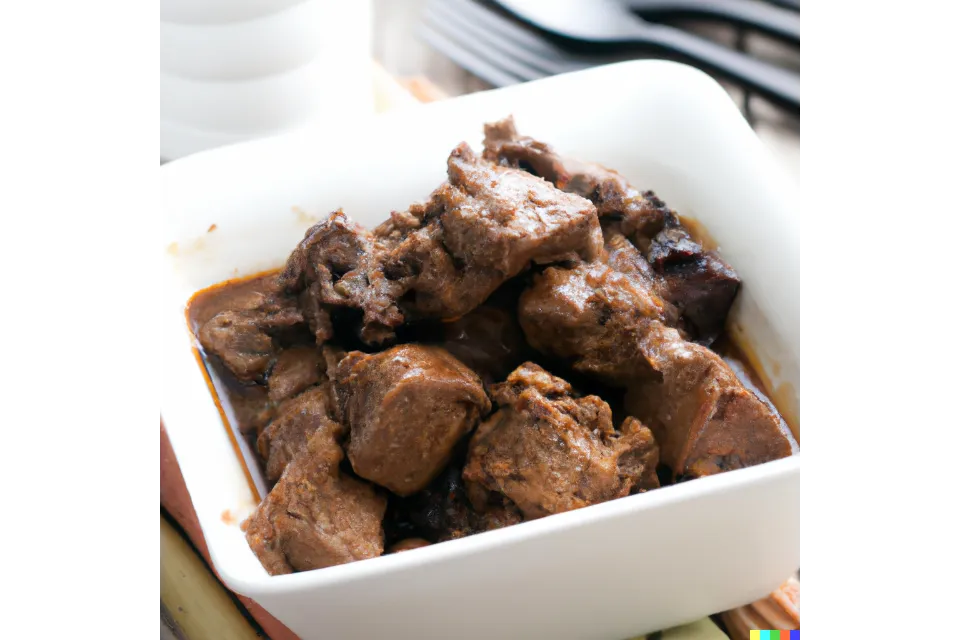
Brian Kennett
Amateur Chef and Foodie Extraordinaire
A comprehensive review of wonderful Filipino food names and pictures
With travel opening up again due to the Covid ‘calming,’ we’re all packing our cases and jumping on planes again. The world has re-opened. I saw this in action during my recent trip to the Philippines and our house in Bohol. So many foreign visitors in Bohol and Panglao, from all nations. So I thought it was a perfect time to give you some insight into the beautiful Filipino food and Filipino cuisine by sharing 40 Unbelievable Filipino Food choices.
As the COVID-19 pandemic continues to recede in 2022, many people are starting to feel much more comfortable about traveling again. After 2-3 years of lockdowns, quarantines, and restrictions on movement, being able to explore new places, see again well-loved places, and see loved ones who live far away is a welcome one. It’s on. The world is open again, and that means access to local cuisine, Filipino cuisine. 40 Unbelievable Filipino Food choices.
Table of Contents of 40 Unbelievable Filipino Foods (2023)
Filipino Food
The indigenous Philippines, Spanish, Chinese, and American cooking styles are all woven into what is known as Filipino food. Filipino food is characterized by its mix of sweet, salty, and sour flavours. Rice is a staple throughout the archipelago, as is coconut, and a balance of all three flavours is found in many dishes.
Typical Filipino meals are composed of vegetables, seafood, dairy, meat, and rice. Soups and stews play a big role in Filipino cuisine. Popular Filipino cuisine includes Tocino, Kinilaw, Sinigang, Kare-kare, Sisig, Adobo, Humba, Lechon, and Adobo.
Of the above, one of the most well-known meals in Filipino cuisine is the infamous Adobo, and it is prepared by first marinating meat (often chicken or pork) in a sauce comprised of vinegar, soy sauce, and garlic, and then frying off until the meat until it is fork-tender. Other standout Filipino foods include Lechón, which is roasted whole pig, or Bellychon if on the smaller scale; Lumpia, which is a type of spring roll; and Sinigang, which is a sour soup prepared with tamarind broth and vegetables.
Desserts and snacks are also a significant part of the Filipino food tradition. Some top-if-the-shop examples of these include Halo-halo, which is a shaved ice dessert with a blend of sweet beans, fruits, and ice cream; and Turon, which is a deep-fried banana that is covered in brown sugar.
One of the standout features of Filipino food is its emphasis on bold and savoury flavours, often achieved through the use of ingredients like vinegar, soy sauce, chilli, calamansi and garlic. Filipino dishes are often seasoned with a mix of these and other aromatic spices, giving them a distinctive and satisfying taste.
They are also venture into the weird in Filipino food, and we’ll be sharing a few of those for you. Dog, frogs, civet cats, monitor lizards, snakes, fruit bats, locusts, ant eggs, and mole crickets are only few of the exotic animals eaten by Filipinos. Balut, the duck embryo within an egg, is often consumed with Tanduay Rum and beer by Filipino men.
The Filipinos, Chinese, and Vietnamese use fertilized duck eggs with embryos in varying stages of development as an aphrodisiac. Marcos advocated for the underprivileged to improve their lot in life by supplementing their diet with earthworms and snails. Do you get the picture?
Ready for the journey across the Philippines to visit Pangasinan, Baguio, Batangas, Quezon City, Sinulog Festival, Pampanga, Palawan, San Juan, Davao City, Panagbenga Festival, and Baguio City.
What is a favourite Filipino cuisine condiment?
One very special and very unique ingredient is Tuba. Have you ever tried it? Tuba is a type of fermented palm wine that is popular in the Philippines and other Southeast Asian countries. It is made by collecting the sap from the flower buds of the coconut palm or nipa palm and allowing it to ferment naturally.
In the Philippines, Tuba is often sold by vendors who carry large barrels of fermented palm wine on their backs and dispense it into small glasses or containers for customers. It is also a common sight at celebrations and festivals, where it is often served as a refreshment. OK, I hear you. That’s great, but the relationship to food and 40 Unbelievable Filipino Food choices is…?
What is Sukang Niyog?
Well, that very same Tuba can be made into a vinegar that is a massive favourite with Filipinos as a dipping sauce for a vast number of our 40 Unbelievable Filipino Food choices. You can also get a super-spicy version of Tuba Vinegar, and I love that one. Tuba vinegar, also known as Sukang Niyog, tuba-tuba vinegar or coconut vinegar.
How do you make Tuba Vinegar?
Tuba vinegar is made by collecting the sap from the flower buds of the coconut or nipa palm and allowing it to ferment naturally. The resulting liquid is then strained and bottled as vinegar. Tuba vinegar has a brownish colour and a slightly cloudy appearance due to the presence of sediment and microorganisms from the fermentation process.
In the Philippines, tuba vinegar is often used as a condiment for dipping sauces, marinades, and dressings. It is also a common ingredient in various dishes such as adobo, a popular Filipino braised meat dish, and kinilaw, a raw fish dish similar to ceviche. Now you see the context of this blog, right?
Coconut vinegar is also believed to have a number of health benefits, such as aiding in digestion and helping to lower blood pressure (I should be drinking this stuff daily). Funnily enough, you can drink this fermented coconut sap, usually mixed with Coca-Cola. I have had this with some of the older folk whilst visiting Mabini Barangay, in Bohol. I felt fine until I stood up and it was like someone had amputated my legs. This delicious concoction is called Tuba. It is a traditional beverage in the Philippines and is known for its sweet, slightly fruity flavour and strong alcoholic content (tell me about it…)
40 Unbelievable Filipino Food choices
Many people all over the world take pleasure in eating Filipino food because it is a tasty and varied fusion of culinary traditions from a wide variety of different cultures. Now to get deeper into a number of those through our 40 Unbelievable Filipino Food choices.
No list of Filipino food would be complete without adobo. A ubiquitous Filipino dish in every household in the Philippines, it’s Mexican in origin. But Filipinos found that cooking meat (often chicken and pork) in vinegar, salt, garlic, pepper, soy sauce, and other spices was a practical way to preserve it without refrigeration.
This cooking style can be applied to different meats or even seafood. It’s best to sample it in a Filipino home, but there is even a rather garlicky version, Lamb Adobo that can be found at Abe Restaurant in Taguig.
Adobo is such a popular and beloved dish in the Philippines that it is considered the national dish of the country.
What are the origins of Adobo?
The origins of adobo in the Philippines can be traced back to pre-colonial times when indigenous communities in the Philippines used vinegar and spices as a way to preserve and flavour their food. During the Spanish colonial period, Adobo became even more popular and was introduced to other parts of the Philippines. The Spanish introduced new ingredients and cooking techniques, including the use of soy sauce, which is now an integral part of the adobo marinade.
What is Adobo?
Adobo is a popular dish in the Philippines cuisine that typically consists of meat, poultry, or seafood that is marinated in a mixture of vinegar, soy sauce, and garlic, and then simmered in the marinade until tender. The dish is typically served with rice and is known for its savoury and slightly tangy flavour.
There are many variations of Adobo, with each region in the Philippines having its own unique twist on the dish. Some versions include the addition of spices such as bay leaves or peppercorns, while others may include coconut milk or other ingredients to give the dish a different flavour profile. Overall, Adobo is a flavourful and hearty dish that is enjoyed by many people in the Philippines and around the world.
How to cook Adobo?
Here’s my 1st ever attempt at cooking Adobo using a different ingredient than the usual chicken or pork for an Adobo. I made it with Chicken Livers.
I used the recipe that we posted on our sister blog which you can read here Philippines Food 101: Simple Filipino Recipes. I soaked the chicken livers in milk 1st to remove the smell and bitterness, and when the sauce had been absorbed in the final stage of cooking, I added a little Olive oil. My Wife’s verdict was that it was exceptional and she was super proud of her husband and his 1st attempt at cooking Adobo. I am mightily proud of myself because of that review from a Filipino about one of their iconic dishes.
Phew! I think she looks beautiful, the Adobo, that is.

The Lechon is the most invited party guest in the Philippines. The entire pig is spit-roasted over coals, with the crisp, golden-brown skin served with liver sauce, the most coveted part. You get this at every major event from Fiesta, and birthdays to just about anything. It is THE stable Filipino food for gatherings of any type. It’s family food. It encourages gatherings.
It is just off-the-charts good, especially with some Native Sauce, a combination of vinegar, soya sauce, Calamansi, chili, and sometimes fresh chopped green tomato.

What is Lechon?
Lechon is just the most traditional Filipino dish that involves roasting a whole pig over an open fire or spit for hour after hour. Yes, in effect it is reverse searing, low and slow. The Lechon pig is seasoned with a mixture of herbs and spices before being cooked, and the skin is typically crispy and crunchy while the meat is tender and flavourful. Lechon is often served at special occasions and celebrations, and it is a popular dish throughout the Philippines. It is typically served with rice, vegetables, and a dipping sauce made from vinegar, soy sauce, and garlic.
How to cook Lechon?
In Cebu, the stomach of the pig is stuffed with Star Anise, pepper, Spring onions, Laurel leaves, and Lemongrass resulting in an extremely tasty Lechon, which needs no sauce.
Lechon, or the roasting of a whole pig, is a traditional cooking technique that has been practiced for centuries in various parts of the world, including the Philippines. In the Philippines, Lechon has a long history and is an integral part of the country’s culture and cuisine. It is a popular dish that is often served at special occasions and celebrations, such as weddings, birthdays, and holidays.
I have eaten Lechon at every single one of these events on my Filipino adventures.

What is the origin of Lechon?
The origins of Lechon in the Philippines can be traced back to the pre-colonial era when indigenous communities in the Philippines cooked whole pigs over an open fire or spit. The Lechon pig was typically seasoned with herbs and spices before being cooked, and the skin was crisp and crunchy while the meat was tender and flavourful. Lechon became even more popular during the Spanish colonial period when it was introduced to other parts of the Philippines and became a popular dish among the Spanish colonists and the local population.
The pork dish known as Lechon is typically accompanied by a sauce made from the liver that has been simmered in sugar, fresh herbs, and vinegar. In the event that there are any leftovers after the feast, they are frequently used to make Lechon slaw, which is prepared by slowly cooking the leftovers with vinegar, garlic, and liver sauce to add an additional layer of taste.
In addition to the Philippines, countries such as Cuba, Puerto Rico, the Dominican Republic, and Spain are among those that place a strong emphasis on culinary preparation. Lechon has been hailed as the “best pig in the world” by a number of renowned chefs; hence, giving it a try is highly recommended.
Today, Lechon is a beloved and iconic dish in Philippine cuisine and is enjoyed by people of all ages and backgrounds. It is, without a doubt, one of my all-time favourite Filipino foods. Younger Filipino Chefs are now also bastardizing Lechon with Belly-Chon which is the same stuffing, seasoning, and cooking style but just using the belly of the pig rolled up. And a very good Chef mate of mine in Bohol at Smoque Bar & Grill, is now supplying the very best Cochinillo that I have ever eaten.

What is Cochinillo?
A piglet that has been roasted after having been fed sow’s milk for around two to six weeks. It is crisp, succulent, and has meat that is moist and flavourful that readily slips off the bone. There are several variations of roasted suckling pig throughout many different cultures, but the one that is most well-known comes from Segovia, which is located to the north of Madrid in Spain, and now, Bohol.
The buttery smoothness of Cochinillo flesh and the light, crisp, golden-brown skin are what set it apart from other types of pork. It demonstrates a suppleness and delicacy that is not possible in the ordinary Lechon by being simply sliced with a porcelain plate, as Jude did recently at Wifey’s birthday. The majority of Cochinillo in the Philippines is usually served with a Native Sauce of vinegar, chopped shallots, and chopped chili.
The preparation is the key to making a Cochinillo that is extremely mouth-watering and delicious. Before being marinated in a particular mixture of olive oil, herbs, and spices, each piglet is meticulously washed and trimmed after having been carefully picked. After that, it is given a smokiness that can only be achieved by roasting it over wood and coal in a brick oven that has been custom-made for the purpose. During this step, it is allowed to cook in its own natural juices.
Referenced by Ernest Hemingway in his novel, “The Sun Also Rises,” Cochinillo has been a much sought-after delicacy in Spain since the 18th century. I love Ernest Hemingway, a massive boozer, great writer, and lover of the same locations as me. Sloppy Joe’s in Key West, the USA is a massive favourite mutual haunt. Is Cochinillo the ‘new’ Lechon? Watch this space.
What is Sisig?
Nothing goes to waste in Filipino food. In the culinary capital of Pampanga, they turn the pork’s cheeks, head, and liver into a sizzling dish called Sisig. The crunchy and chewy texture of this Filipino dish is a perfect match for a cold beer. Serve with hot sauce and Maggi Knorr seasoning to suit the preference of you and your buddies.
This is why I enjoy eating so much. A humble Sisig can be so varied in its ingredients, style and even serving. This, isn’t even a localized to Barangay phenomenon. The difference in Sisig versions can be equivalent to as close as 200 yards apart. Sisig is a Filipino delicacy with many different flavours and textures.
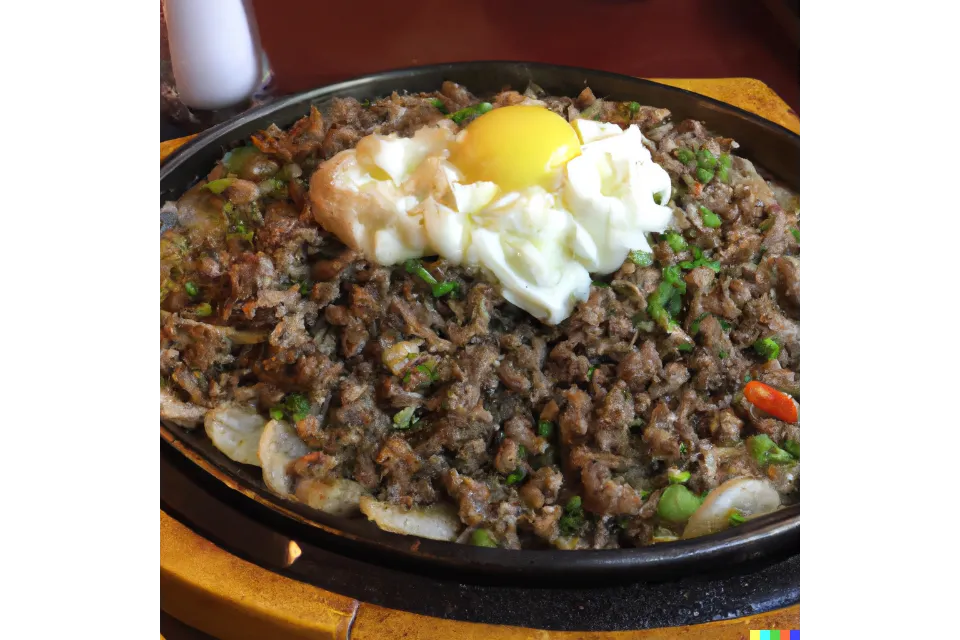
If you’ve been hearing Sisig pop up in conversations lately, that might have something to do with the late chef Anthony Bourdain’s prediction that Filipino food will become one of the trendiest cuisines in America, and the chopped pork dish, Sisig, could be many first-timers’ gateway to those flavours. I love Bourdain and had the most amazing opportunity to meet him with Singapore’s King of Hawkers, KF Seetoh, at Singapore’s Streetfood Congress.
What is the origin of Sisig?
In a Kapampangan lexicon, this cuisine made its first appearance in the 17th century. Chicken liver, pork neck, cheek, ears, and snout are common ingredients. Then, it is traditionally served on a sizzling dish with Calamansi, onions, chili peppers, and a raw egg. Apparently, it refers to munching on a sour and salad-like snack. Have a read of the full blog of our most-loved Filipino dish, Sisig, the multi-personality Filipino dish.
Credit goes to Aling Lucing, who invented the modern version dish at a humble stall along the train railways in Angeles City, Pampanga. It is believed to have originated in the 1970s. Cunanan is credited with inventing the dish by using various parts of a pig, including the head and liver, that were traditionally discarded or not used in other dishes. She diced or minced the pork and cooked it with spices and other ingredients, and the resulting dish became known as Sisig. Her creation earned Angeles City the title “Sisig Capital of the Philippines.”
Over time, Sisig gained popularity and spread to other parts of the Philippines, and it is now a beloved and iconic dish in the country. It is often served at special occasions and celebrations, and it is a popular street food and bar snack throughout the Philippines.
Modern Filipino chefs are now upping the ante. Like Chef-owner of Kubo Restaurant in Singapore, offering up his twist on Sisig including his not-so-secret ingredient of Foie Gras. I kid you not. I am a bit of a purist though. I’ll go for the original any day of the week.
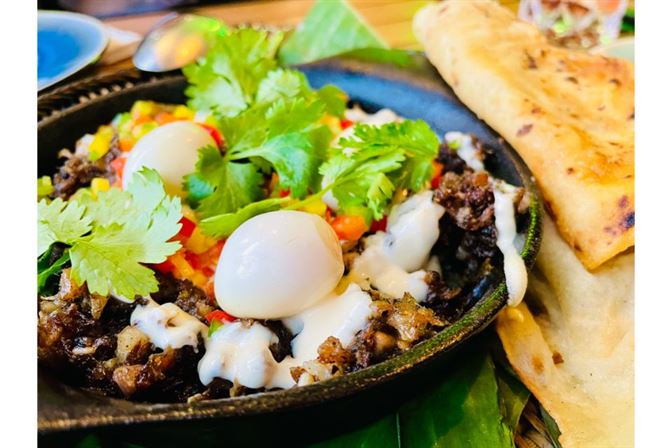
How to cook Sisig?
Click here to get your Sisig fix at home wherever you are. Cook it yourself. Now, what I found in Singapore was that it was hard to find the pig head parts for a more traditional Sisig. So I replaced the meat element of this dish with other Filipino food favourites, namely Spam and Corned Beef. You beauties. Click here for my Spam & Corned Beef Sisig Recipe.
What is Crispy Pata?
Crispy Pata is pork knuckle that is simmered, drained, and deep-fried until crisp. The meat is tender and juicy inside, with a crisp, crackling exterior. Served with vinegar, soy sauce, and chili, AKA ‘Native Sauce’.
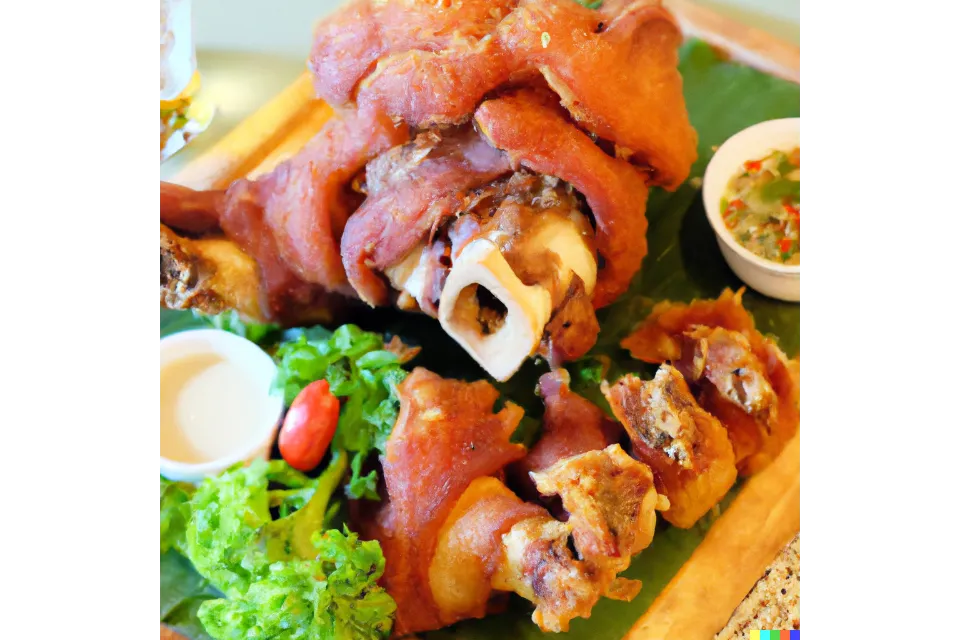
How to cook Crispy Pata?
Crispy Pata is a Filipino dish that consists of a deep-fried pork leg or trotter that is served with a dipping sauce. The pork leg is typically boiled until tender, then seasoned with a mixture of herbs and spices before being deep-fried until the skin is crispy and the meat is tender and flavourful. It is beer food on steroids. I demand that you have an icy-cold Pilsen when consuming your Crispy Pata.
What are the origins of Crispy Pata?
In the Philippines, the dish known as Crispy Pata, which is analogous to the German dish known as Schweinshaxe, has a very recent history. Rodolfo Ongpauco, whose mother owned the restaurant Barrio Fiesta in Caloocan, which is located to the north of Manila, is credited with having “created” it in the 1950s after he decided to deep-fry some unwanted pork legs.
Crispy Pata is now one of the most popular meals in the Philippines and is, for better or for worse, what most people connect Filipino food with, despite the fact that there is a great deal more to Filipino cuisine than just pork that has been deep-fried.
Crispy Pata is often served as an appetizer or a main dish, and it is a popular dish in the Philippines. It is typically served with a side of dipping sauce, which can be made from a mixture of vinegar, soy sauce, and garlic (AKA Native Sauce), or a sweet and spicy sauce made from honey and chili peppers. Crispy Pata is often accompanied by rice and vegetables, and it is a staple at many Filipino festivals, and celebrations, but also readily available at any local restaurant and street food vendor. It is everywhere.
You have to eat this dish with rice. And you have to bring friends to share it with and share some beers. Crispy Pata is huge and way too big for one diner. If you’re by yourself, try ordering Lechon Kawali, which is deep-fried pork belly and also very good. And dipping sauces make all the difference. I love my Native Sauce, AKA Sawsawan.
Sawsawan is a Filipino food term that refers to a dipping sauce or condiment that is typically served with grilled or fried dishes. It is usually made by mixing together various ingredients, such as vinegar, soy sauce, garlic, onions, calamansi, and chili peppers, to create a flavourful and pungent sauce that is used to add flavour and moisture to the dish. Sawsawan is commonly used in Filipino cuisine and is often served alongside dishes like Crispy Pata, grilled pork or chicken, and fried fish as the vinegar cuts through. It can be made in a variety of different styles and flavours, depending on the preferences of the cook and the specific dish it is being served with.
What is Chicken Inasal?
Yes, Chicken Inasal is grilled chicken. But in Bacolod, this is no ordinary grilled chicken. The meat is marinated in lemongrass, calamansi, salt, pepper, and garlic and brushed with achuete (Annatto seeds) oil. Every part of the chicken is grilled, from the paa (drumstick), pecho (breast), baticulon (gizzard), atay (liver), pakpak (wings) and corazon (heart). It must be eaten with a generous serving of garlic rice, with some of the orange oil used to marinade the chicken poured over the rice.

How to make Chicken Inasal?
Chicken Inasal is a type of Filipino food that consists of grilled chicken that is marinated in a mixture of spices and coconut vinegar. The chicken is usually basted with marinade while it is being grilled, and it is typically served with a dipping sauce called sawsawan, which is made with vinegar, soy sauce, and other seasonings. Chicken Inasal is a popular dish in the Philippines and is often served at barbecue parties and other social gatherings. It is typically cooked over hot coals or a grill and is known for its smoky, savoury flavour and tender, juicy meat.
What are the origins of Chicken Inasal?
Chicken Inasal is believed to have originated in the region of Bacolod, which is located on the island of Negros in the Visayas region of the Philippines. So, yes, Chicken Inasal is very popular indeed in Bacolod.

Our favourite Chicken Inasal restaurant is in Tagbilaran City, the capital of Bohol. It’s a humble restaurant called Payag, and it is a beauty. We will categorically go to eat at Payag every time we visit the Philippines, and have done so for the past 15 years or so.
Click here to read our full review of Payag Restaurant, Tagbilaran, Bohol. They do much more than just Chicken Inasal at Payag, and it is super cheap $. I also love the fact that the owners are so in love with chickens as the dining room is full to the brim with chicken nick-nacks, ornaments, paintings, statues, and so on. It’s crazy, but crazy good.
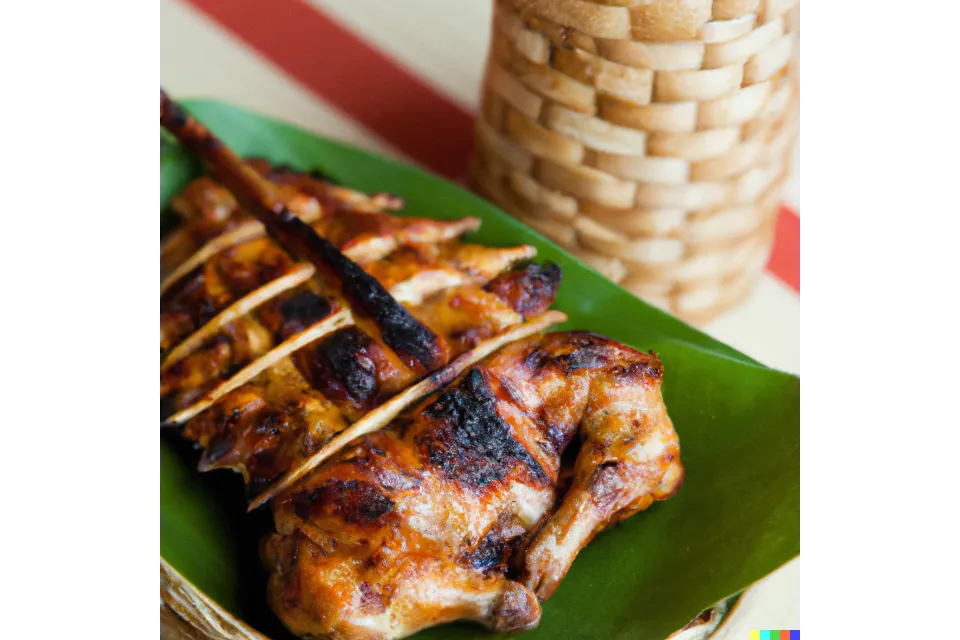
Taba ng Talangka
What is Taba ng Talangka?
The fat of a small variety of crabs is pressed and sauteed in garlic. This cholesterol-laden Filipino food is often used as a sauce for prawns or eaten with fried fish and rice. The best Taba ng Talangka comes from the provinces of Pampanga, Tarlac, and Bulacan. The name literally means “crab fat” (or even more literally “fat (taba) of crab (talangka)”).
So, basically, it is a Filipino seafood paste called Taba ng Talangka (Tagalog pronunciation: ta’be nan telen’ka, commonly known simply as Aligi. It is made from the roe and the reddish or orange tomalley of river swimming crabs or Asian beach crabs (Talangka).
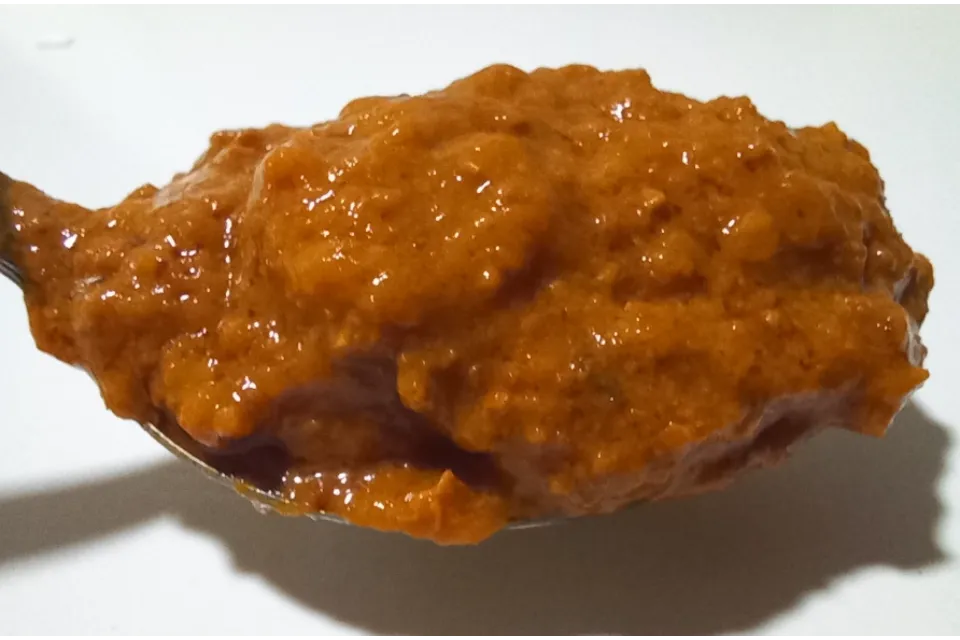
How to make Taba ng Talangka?
Taba ng Talangka is revered as a type of Filipino food delicacy that is made from the fat of the small, edible crab known as Talangka. It is a popular snack in the Philippines and is known for its rich, flavourful taste and creamy, luscious texture. Taba ng Talangka is typically made by rendering the fat of the Talangka over low heat until it is fully melted and has a liquid consistency. The resulting fat is then cooled and solidified before being cut into small pieces and served as a snack or used as an ingredient in various dishes.
Is Taba ng Talangka healthy?
Taba ng Talangka is often used in Filipino cuisine as a condiment or flavouring agent, and it is believed to have a number of health benefits due to its high content of Omega-3 fatty acids and other nutrients. It is believed to have been enjoyed as a snack or condiment in the Philippines for many centuries, as the Talangka Crab is found in abundance in the coastal waters of the country.
Click here to have a look at a very old recipe from us for Filipino-style stuffed crabs.
Also, have a click here for our recent foray into cooking Chinese Hairy Crabs with 5 different hot sauces.
Interestingly enough it is again the roe of the Hairy Crab that is the big pull for this dish. You’ll see that from the blog, and also note that the male and female roe is completely different.
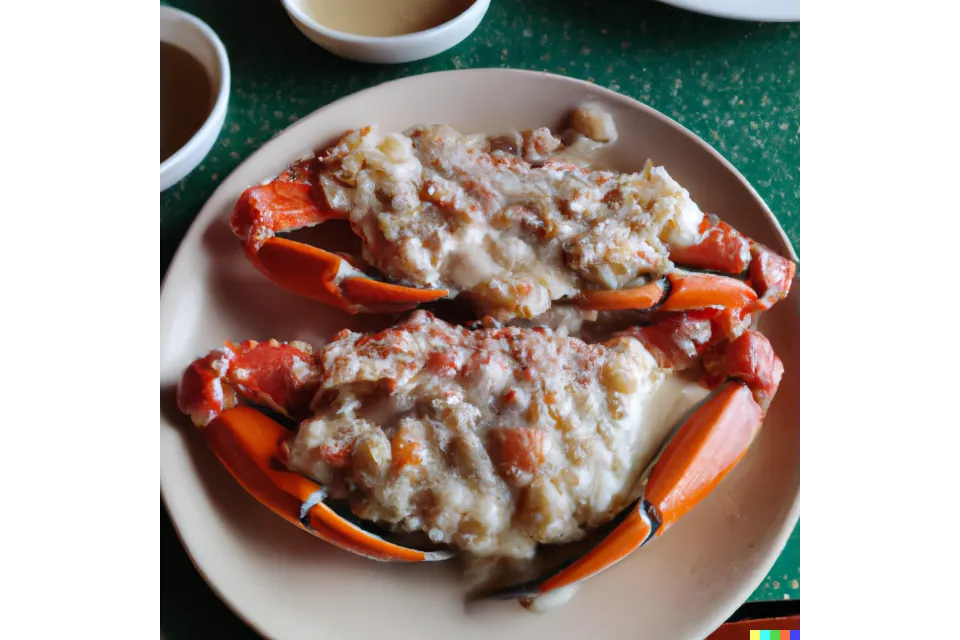
It is possible to serve it as a side dish with white rice, use it as a sauce, or include it into a variety of seafood meals. In particular, it is a component in a dish called Inaliging Sinangag, which is a variation of the traditional Filipino dish Sinangag, which is fried rice. This is surely not a favourite of this writer.
When Filipinos have guests, they don’t skimp. Pancit Palabok gets served at most birthday parties and oozes with flavours and textures. This Filipino noodle dish is layered with rice noodles, a rich orange sauce made from shrimp broth, the ingredients such as pork, hard-boiled eggs, shrimp, chicharon (pork rinds), and sometimes oysters and squid. It’s a cracker.
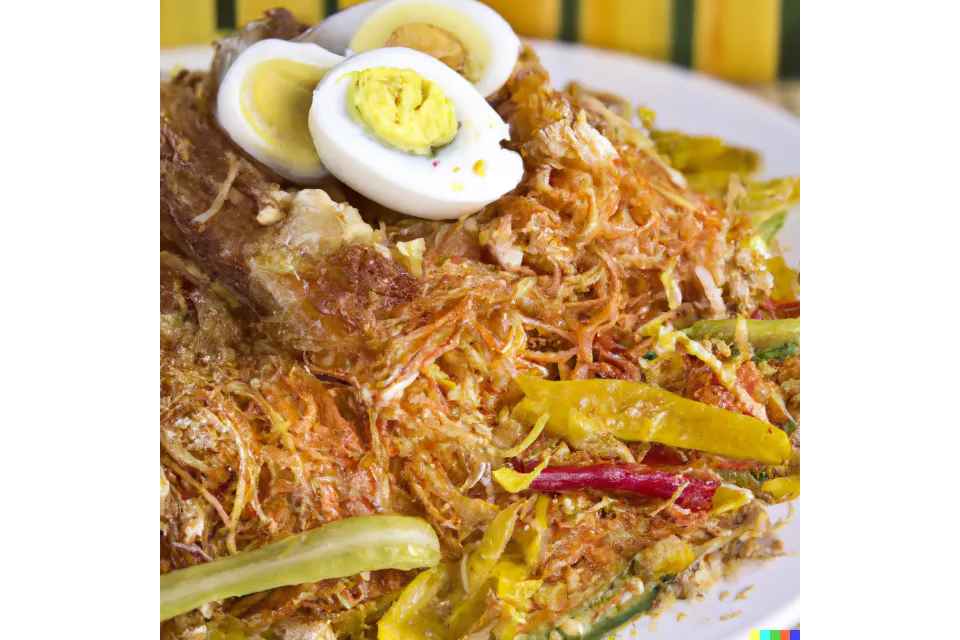
How to make Pancit Palabok?
Pancit Palabok noodles are usually cooked in shrimp broth to maximise the shrimp flavour and then topped with the sauce, all that other seafood, and other ingredients, such as boiled eggs, crushed pork rinds, and sliced green onions. Pancit Palabok is a popular dish in the Philippines and is often served at celebrations, fiestas and special occasions. It is renowned for its savoury, slightly sweet flavour, and its colourful and visually appealing presentation. It surely is one versatile dish.
What is Pancit Palabok?
Pancit is another name for the dish that is commonly known as Palabok (Noodle dish). Palabok, in tagalong (a Philippine language), means “additional flavour”. Pancit Palabok is a lovely noodle dish that may be prepared in a variety of ways for festive occasions; nevertheless, the origin of Palabok is not restricted to specific people (it is often attributed to the Filipino).
What is the origin of Pancit?
The dish known as Pancit really has its roots in Chinese cuisine; yet, it is commonly referred to as Palabok because of the orange hue of its sauce as well as the ingredients that are included in the sauce that is used to souse the noodles. When Chinese merchants went to the Philippines in the 9th century, it is said that they brought a dish called baon, which was homemade, with them when they traded with the locals on the islands.
This dish was known as Pancit, which in the Hokkien dialect of Fujian, signified “rapid food” or “food that can be prepared quickly.” When the Chinese merchants ran out of food at home, they resorted to eating the rice noodles that were common in the area as a makeshift replacement for the wheat they normally ate.
Because of this food experiment, a new discovery was made: it turned out that rice noodles were simpler to cook than Chinese wheat noodles, and they were fantastic for presenting a wide variety of toppings and sauces. Pancit is the name that was given to this assortment of noodles.
During the Spanish colonization of the Philippines (1520-1898), also known as the Spanish occupation, the noodle dish quickly became the takeout meal sold by Chinese hawkers to factory workers who had little to no time for housework or meal preparation. This was because factory workers were required to work long hours.
At the time, Binondo served as the centre of activity for everything from street sellers and hawkers to the establishment of the first restaurants in Manila, which were known as Panciterias. These Panciterias eventually evolved into the first restaurants in the Philippines, serving both locals and tourists.
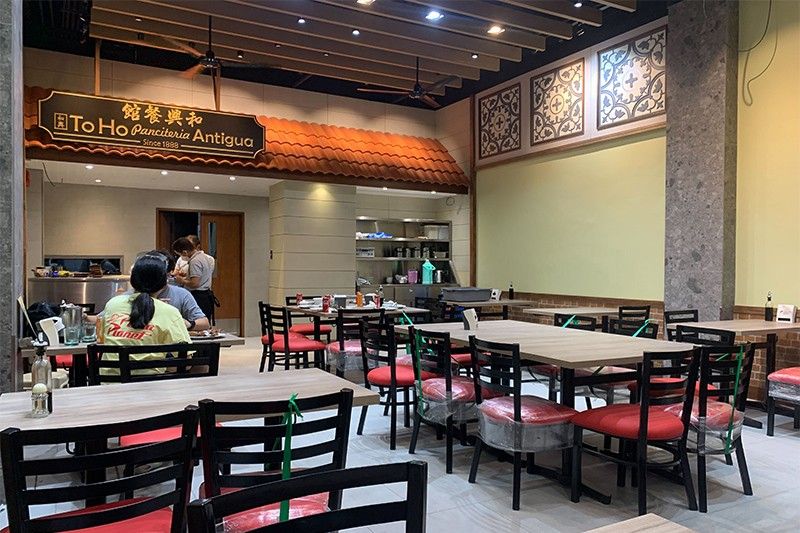
Panciterias created an incredible array of different Pancit varieties, including;
- Pancit Bihon (Hokkien term meaning rice vermicelli),
- Pancit Guisado, uses rice sticks with chicken, vegetables, chicharron and pork,
- Pancit Canton where wheat noodles are stir-fried in a ginger and soy sauce, garnished and tossed with squid, sliced pork, tinted quail eggs (neon-orange), vegetables and shelled shrimp,
- Pancit Luglog, which means “to dunk in liquid”. The thick rice noodles are boiled in water, mixed with achuete sauce and garnished with fresh seafood (oysters, squid and shrimp),
- Pancit Batil Patong, named after the ways eggs are being used to top the dish. Miki noodles are stir-fried with bean sprouts and carabao beef and garnished with a fried egg called “patong” and served with batil, a whisked bowl of egg-drop soup,
- and then we have the Pancit Palabok.
Despite the perennial heat, Filipinos often enjoy sipping piping hot Bulalo soup made with from freshly slaughtered Batangas beef. The Bulalo broth is rich with flavours seeped from the beef after boiling for hours. The bones are big, meaning more bone marrow to enjoy, that simply melts into the broth giving it maximum umami.
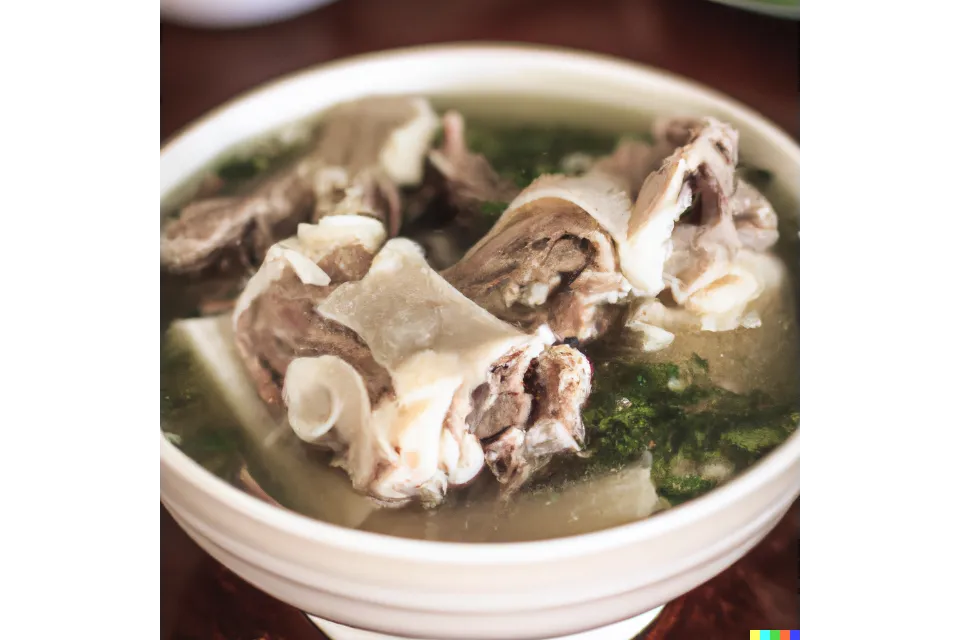
What is Bulalo?
Bulalo is a type of Filipino stew made with beef shank and bone marrow. The beef is slowly cooked in a broth made from beef stock and various seasonings, such as onions, garlic, and bay leaves until it is tender and flavourful. The dish is known for its rich, hearty flavour and the tenderness of the beef, which is typically served with the bone marrow still inside the bone. It is a cracking soup. One of my all-time favourites.
What is the origin of Bulalo?
The history of Bulalo in the Phili[[ines may be traced back to the time before the arrival of the Spanish in 1565. At that time, the most frequent techniques for cooking were boiling, grilling, steaming, and roasting.
Many people believe that Bulalo originated in the Southern regions of Luzon. However, opinions differ as to the specific city or province where it would have been prepared for the first time. Some people think it originated in the province of Batangas, and others think it originated in the municipality of Tagaytay, located in the province of Cavite. In this province they have rows upon rows of restaurants all serving Bulalo all hours of the day and night.
Bulalo is a very popular sharing dish in the Philippines and is often served at family gatherings and special occasions. It is typically served with steamed rice and a variety of vegetables, such as bok choy, cabbage, or string beans, on the side. Other ingredients, such as corn on the cob or potatoes, may also be added to the stew to vary its flavour and texture.
How to cook Bulalo? Try my very own Bulalo Recipe.
Click here to get your hands on our very own Filipino Bulalo Recipe.
Bulalo is native to the Southern Luzon region of the Philippines, particularly in the provinces of Batangas and Cavite. In Santo Tomas, Batangas, there’s a long row of restaurants along the highway all serving Bulalo. One of those is the infamous Rose and Grace Restaurant, Maharlika Highway Batangas, Santo Tomas, Luzon 4324.
A Bulalo Recipe will vary, sometimes dramatically by region, province, and even barangay. It is so versatile. So you could have a go at mine, give it a tweak and make your very own Bulalo Recipe.

Bulalo Recipe
I will now share with you a classic Bulalo recipe that is prepared with cow shanks and marrow bones as the main ingredients. After several hours of slow cooking, the meat is reduced to a thick and savoury soup that is the source of both solace and satisfaction. The following is a straightforward Bulalo recipe for making at home:
Ingredients:
- 2 kg of beef marrow bones and shanks
- 2 big onions, chopped
- 4 cloves of garlic, minced
- 4 large tomatoes, chopped
- 2 cups of cabbage that has been chopped
- 2 cups of bok choy that has been chopped
- 2 cups sliced shiitake mushrooms
- 4-6 glasses cups) of water
- To taste, salt and pepper
- One tablespoon of fish sauce (optional)
- 1 tbsp patis (Filipino fish sauce)
Cornstarch - 2 tablespoons cornstarch
Instructions:
A little amount of oil should be heated in a big saucepan over medium heat. Sauté the onions and garlic until they have become more pliable. Add the tomatoes that have been chopped, and continue to simmer the mixture until the tomatoes have broken down and the sauce has thickened.
Put the beef shanks and bones in the pot, along with four to six cups of water. Bring the mixture to a boil, then immediately drop the heat to a low setting and allow it simmer for two to three hours, or until the meat is soft and the broth has become fragrant and rich.
After adding the chopped cabbage, bok choy, and shiitake mushrooms to the saucepan, continue to simmer the contents of the pot for an additional 10 to 15 minutes, or until the veggies have become more tender.
To taste, season the soup with salt and pepper, and if you’d like fish sauce and patis, feel free to add them as well.
If you like your soup on the thicker side, you can make a thickening agent by combining 2 tablespoons of cornstarch with a little quantity of water in a separate bowl. Then, while stirring the soup, gently add the thickening agent to the soup until it reaches the appropriate consistency.
If you choose, you can top the bulalo with some chopped green onions or some cilantro before serving it hot.
This traditional Filipino meal is sure to satisfy your wants for something hearty and reassuring to eat on a chilly day, and its rich and savory broth is sure to do the trick when it comes to satisfying your cravings. A fundamental component of Philippine cuisine, bulalo is a dish that can stand on its own or be incorporated into a larger meal; either way, it is destined to become a family favorite in your home.
Get in there with this Bulalo recipe. Come on it’s easy. You basically throw everything in a pot. But don’t forget change one thing, add something that’s yours to make your own Bulalo recipe.
What is Kare-kare?
Kare-kare is a stew of oxtail that has the most delicious sauce made from ground toasted rice and crushed peanuts. Banana blossoms, eggplants, and string beans add more interesting textures, making it a complete meal on its own. Kare-kare is usually eaten with steamed rice and bagoong (shrimp paste).
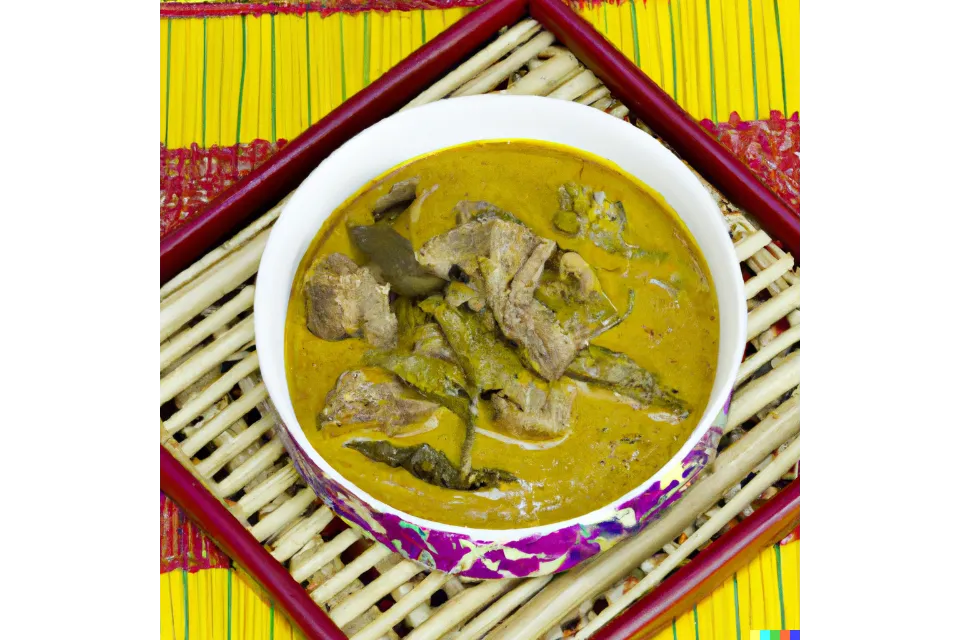
How to cook Kare-kare?
The main ingredients in Kare-kare typically include oxtail, beef, and tripe, which are cooked in a broth made from ground peanuts, garlic, onions, and a variety of spices and seasonings until they are tender. The stew is typically served with a side of steamed rice and a variety of vegetables, such as eggplant, long beans, and bok choy, which are cooked in the peanut sauce. Kare-kare is known for its rich, savoury flavour and creamy, thick consistency, and it is often served with a side of bagoong, a fermented shrimp paste, as a condiment.
What are the origins of Kare-kare?
Kare-kare was invented in Pampanga, the culinary epicentre of the Philippines. Kare-kare was originally a traditional dish of the Moro people, the native inhabitants of the archipelago. It is debated that it was an attempt by Indian soldiers on British ships trying to recreate curry far from home using local annatto seeds and peanuts.
The very term “Kare-kare” gives away the fact that this dish is meant to be a source of comfort, regardless of where it came from in the world. Since “Kare” is the Filipino word for “curry,” you could argue that a loose translation of “Kare-kare” is “very nice curry.” Since it is a customary tradition in the Philippines to mention the name of something twice if it is exceptionally good or desirable, this is how “Kare-kare” came to be.
Kare-kare, both in the manner in which it is prepared and in the ingredients that are commonly used in its preparation, exemplifies a number of significant aspects of Filipino culinary tradition. Kare-kare, along with numerous other traditional Filipino meals, is a slow-cooked, one-pot affair that would have been ideal for individuals who spent early and long days out in the fields. Historically, the majority of Filipinos worked as farmers.
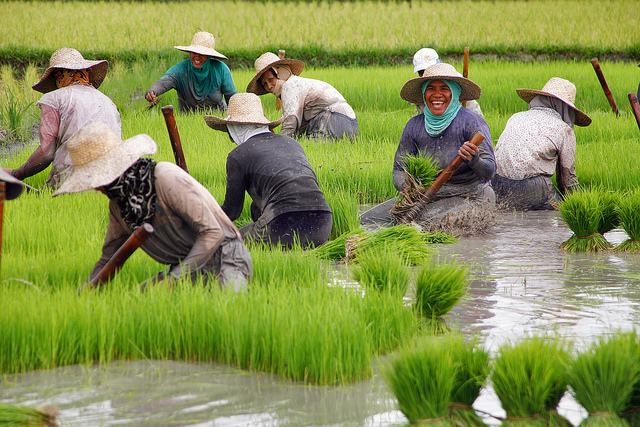
Also, the fact that oxtail and tripe are included in Kare-kare is evidence that Filipinos adhere to a nose-to-tail eating philosophy and make an effort to reduce food waste. This practice also has some historical significance, given that the Spanish colonizers disapproved of eating tripe and oxtail, as well as other types of offal. The assortment of vegetables that are added to the curry varies from region to region, depending on the seasonality and availability of the ingredients.
However, modern versions of the dish typically include long green beans, eggplants, banana blossoms, and bok choy. These vegetables are a mix of ingredients that are native to the Philippines as well as ingredients that were brought to the archipelago by international trade
Serious Filipino gourmands suggest the best cooks come from Pampanga. So do Kamaru. They are Mole Crickets that they cook into a delicious appetizer. What makes this delicacy, Kamaru, special? Well, catching these bugs is tough, and so is cooking them.
What is Kamaru?
Mole crickets, also known as rice-field crickets because they are found primarily in rice paddies in Pampanga, are the primary ingredient in this Kapampangan dish known as Kamaru, which is traditionally prepared by first sautéing the mole crickets in garlic, onion, and tomatoes before slowly cooking them in vinegar.
One easy way to prepare Kamaru is as an Adobo Kamaru, which is basically the traditional adobo, but using the insect as meat, as opposed to the usual pork or chicken (or chicken livers as I did).

Photographer / Credit: Justin Ventura
How to cook Kamaru?
Legs and wings must be removed first, and then the body is boiled in vinegar and garlic. It’s then sautéed in oil, onion, and chopped tomatoes until they turn chocolate brown. These bite-size Kamaro appetizers are crunchy on the outside and moist on the inside. I’m not personally getting that desire to dash to the Philippines and try this.

How did someone one day look at this and think: ‘yummy, I know I’ll pull it legs and wings off, and boil it in vinegar. I am certain that would be delicious…’ How does that moment of blind inspiration happen?
What are the origins of Kamaru?
The origin of this rather exotic food is likely caused during and immediately after World War II. Filipinos used this kind of food for their survival and chose to eat spiders, worms, insects, and even leaves to help them to survive. Now, because of spices, and condiments, Filipinos learned to make these exotic dishes quite mouth-wateringly delicious, despite it still looking rather nasty and yucky.
If you dare, you can sample Kamaru Adobo at Everybody’s Cafe, an authentic Pampango dining institution for many decades now. Everybody’s Café is located at MacArthur Highway Dau, San Fernando, Luzon Philippines. It is very doubtful that I will see you there. This is some bizarre Filipino food, right up there with the hardcore Balut.
What is Sinigang?
Sinigang is such a popular Filipino dish, another one of those infamous, find-everywhere dishes synonymous to the Philippines. It is made by cooking meat or seafood in a super-sour broth.
How to cook Sinigang?
It is typically made sour with Tamarind, which gives the broth a majorly tangy flavour. Other ingredients that are often used in Sinigang include vegetables such as okra, tomatoes, and onions, as well as seasonings like fish sauce and chili pepper. Sinigang is usually served with rice, like most Filipino food, and is a staple of Filipino cuisine.
It is a hearty and flavourful dish that is enjoyed by many people in the Philippines and around the world, and I can vouch for that. My wife loves Sinigang, and we constantly have this wherever we can get our hands on it across the planet. Litres have been consumed on our recent trip to Bohol, I kid you not.
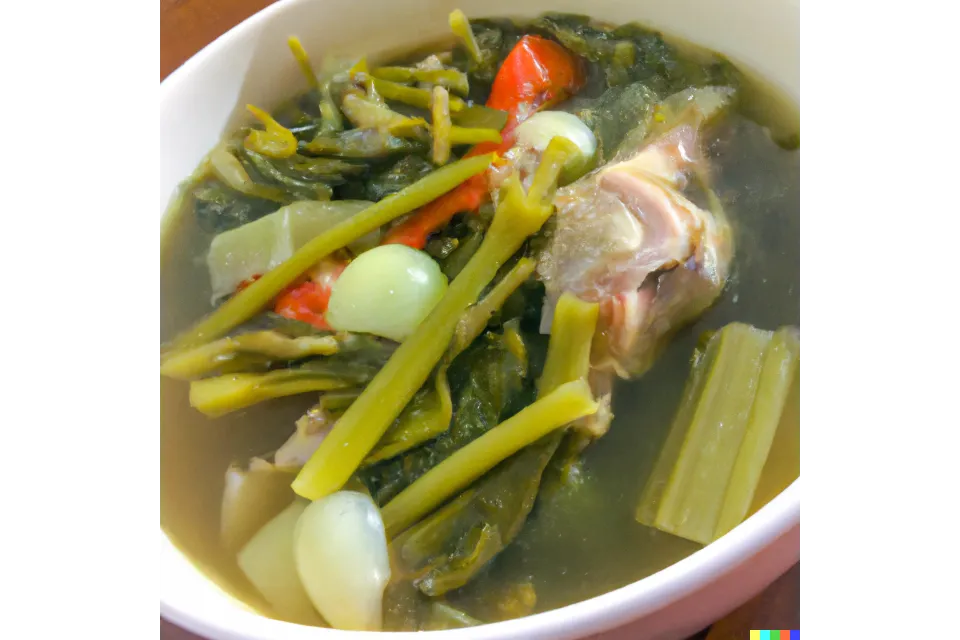
Sinigang is usually soured by Tamarind, but can also be soured by fruits like Kamias or tomatoes.
What is Kamias?
I want to give you some more insights to Kamias. Personally, this is the first time I have heard of this fruit. Kamias is a tropical fruit that is native to the Philippines and is commonly used in Filipino cuisine. It is also known as Bilimbi or Cucumber Tree. The fruit is small, green, and has a cucumber-like shape, hence the name. It has a sour and slightly astringent flavour, so perfect again for the souring agent of Sinigang. Kamias is also sometimes used as a condiment or pickle, and its leaves and bark are used in traditional medicine. The fruit is high in vitamin C and is a good source of antioxidants. How about that?
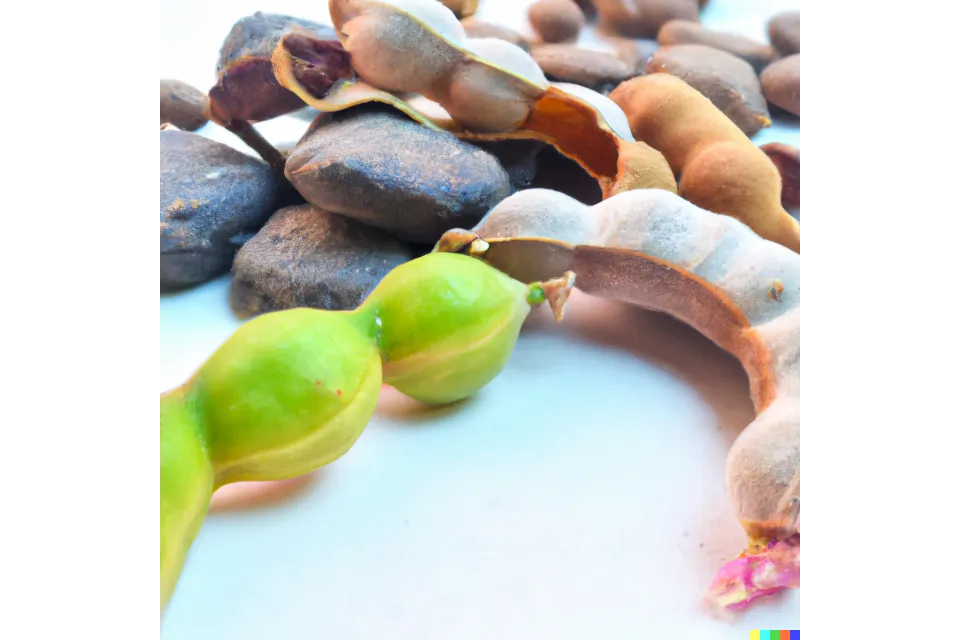
What are the origins of Sinigang?
Sinigang is a traditional Filipino dish that has been a part of Philippine cuisine for many centuries. It is believed to have originated in the Philippines, although there are also similar dishes found in other parts of Southeast Asia. The use of Tamarind is an obvious choice for the sourness as it is a type of fruit native to tropical regions of Asia. Other souring agents that are sometimes used in Sinigang include guava, mango, or calamansi, which is a small citrus fruit native to the Philippines.
A modern, but delicious spin on Sinigang is Sentro 1771’s version called Sinigang Corned Beef.
Sentro 1771, 2/F Greenbelt 3, Makati, Luzon Philippines.
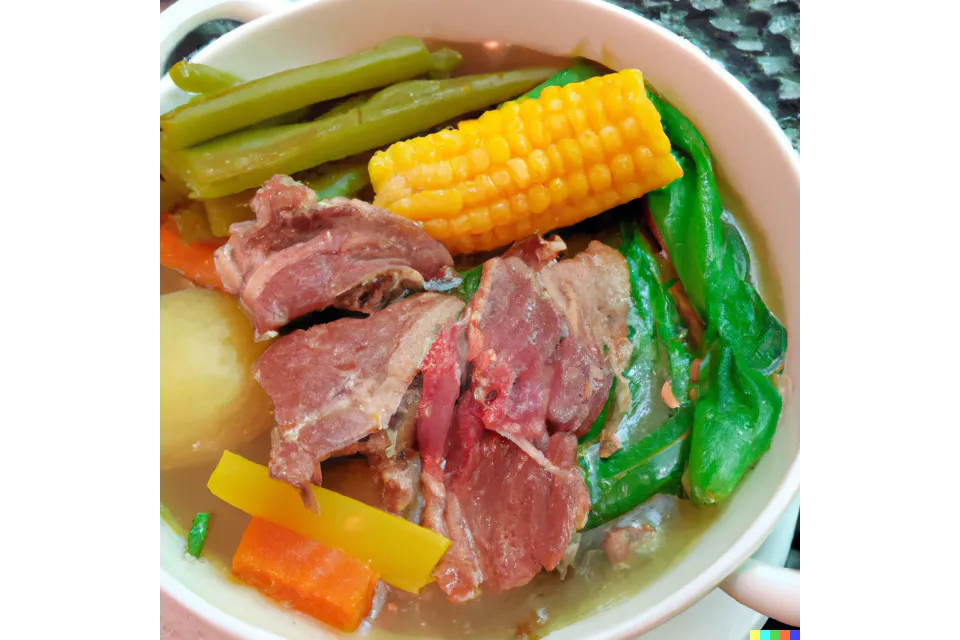
Filipinos are huge rice eaters, and breakfast is no exception. A Tap-si-log consists of thin slices of dried marinated beef, Tapa, are served with fried egg and garlic rice. While it is breakfast fare, it’s also a quick, satisfying meal you can eat anytime and available in most places.
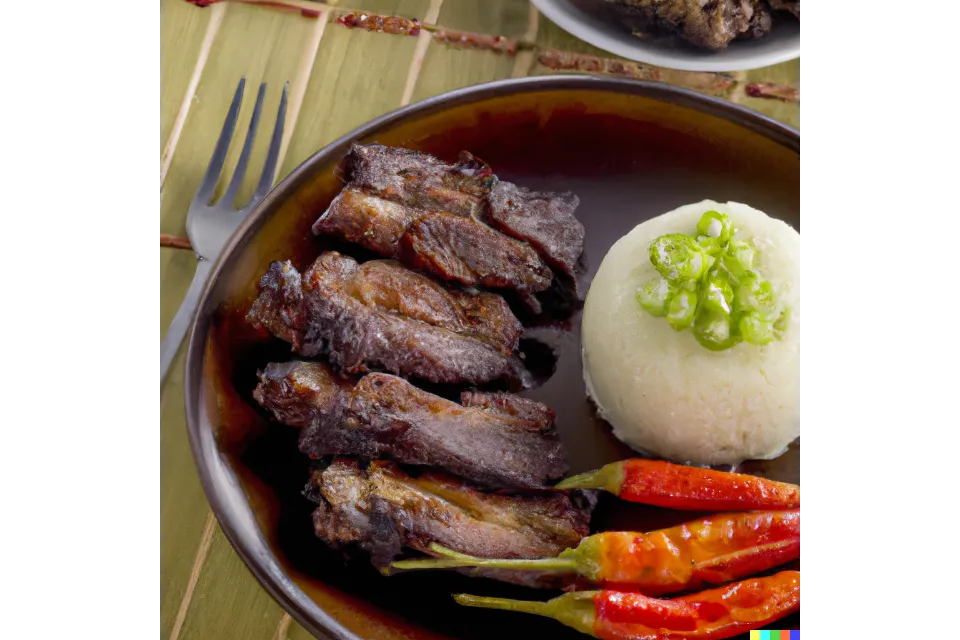
How to make Tapa?
The marinade used for Tapa typically consists of a mixture of soy sauce, vinegar, garlic, and other seasonings, which gives the meat a savoury and slightly tangy flavour.
What is Tapa?
Tapa is a traditional dish in the Philippines and has a long history in the country’s cuisine. Tapa is a popular choice for breakfast or as a snack (with icy-cold beer) and it is also often served at special occasions and events. Tapa is relatively easy to prepare and can be made with a variety of different meat.
What are the origins of Tapa?
The word “Tapa” is derived from the Spanish word “Tapar,” which means “to cover.” It is thought that Tapa was originally made by covering slices of meat with salt and spices and then drying them in the sun, a method of preserving meat that was commonly used in the Philippines and other tropical countries. Hey, where did the Spanish food word Tapas come from? Yes, exactly the same, “to cover”.
Over time, the preparation of Tapa evolved to also include marinating the meat in a mixture of soy sauce, vinegar, and other seasonings before cooking, which gives the dish its distinctive flavour.
Our absolute favourites for this dish, so far in Bohol, are at the pool/beach bar in Henann Resort, Panglao. Just ask for their Air-Dried Beef with Suka (spicy Tubar vinegar), and demand an icy cold beer too. Get your feet in the sand and sit back and stare at the topaz sea and people-watch a while. You will not be disappointed.
You can also read our full review of Henann Resort, Panglao.
Also check out our full review of Gerarda’s Family Restaurant, Tagbilaran City, another family favourite.
They have this incredible Tapa on the bone, again served with some simple Native Sauce. It’s crunchy and fatty and melt-in-the-mouth beefy goodness. Wow!
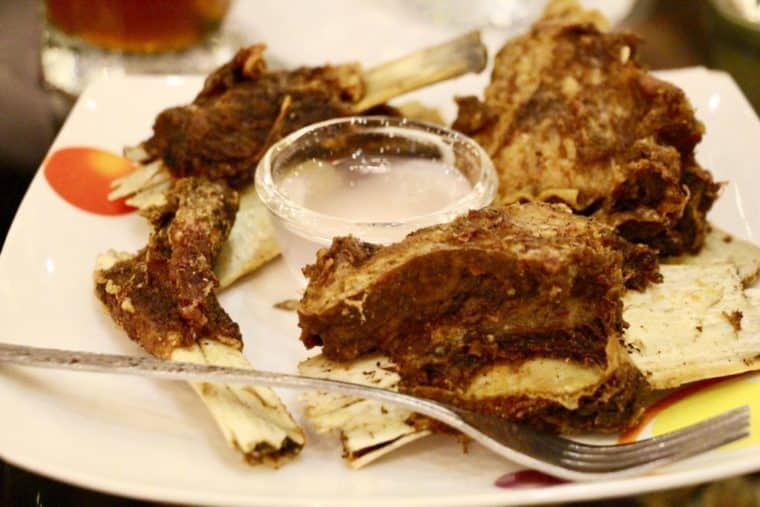
I also had a go at creating my very own version of the infamous Gerarda’s Tapa, and they came out beautifully, even if I say so myself. Click here for my Filipino Tapa Recipe.
What is Dinunguan at Puto?
It may not look appetizing, but Dinuguan is a black dish of pork and pig innards stewed in fresh pig blood seasoned with garlic, onion, and oregano and eaten with white Puto (rice cake) or steamed rice — is a comforting dish for many Filipinos. It’s like a liquid version of the British Black Pudding. My father-in-law was a master of cooking this dish. Papang was literally a family legend for preparing this after a pig had been ‘dispatched’ to become a Lechon. The blood and ‘bits’ would be put in a bowl, and then he would work his magic with his secret blend of spices and seasoning. Bless you, Papang, RIP.
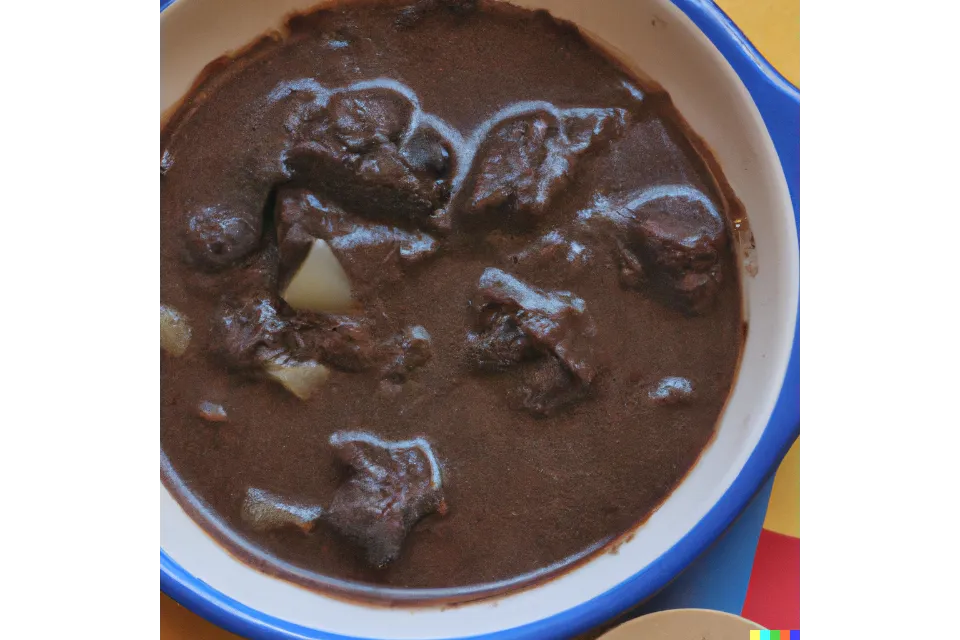
How to cook Dinuguan?
Dinuguan is a super-savory Filipino stew made with pork meat (commonly kidneys, lungs, intestines, heart, ears, and snout) and/or meat, cooked in thick, spicy dark gravy made with pig blood, garlic, chili, and vinegar. In Bicol, they have a regional version that uses Gata called Dinuguan Gata to add more creaminess and some sweetness.
Literally, the name Dinuguan is a variant of the word blood. The Tagalog word for blood is “dugo” so Dinuguan is meaning stewed with blood. It is also sometimes known as chocolate meat.
Have a read here of a family trip we did to Boracay once, when I sampled Dinuguan for the first time. This is my restaurant review of Mang Inasal, Borocay. Now this will blow your mind. Do you think stewed liquid blood would be a popular dish, akin to McClown? Well how about this. Mang Inasal was started by a guy from one location in 2003. It has now grown to 500+ retail outlets across the Philippines. The food is fast and it is seriously good. It’s like McClown on steroids when comparing flavours and quality of produce. Plus, it shows that the Filipinos are dedicated nose to tail consumers.
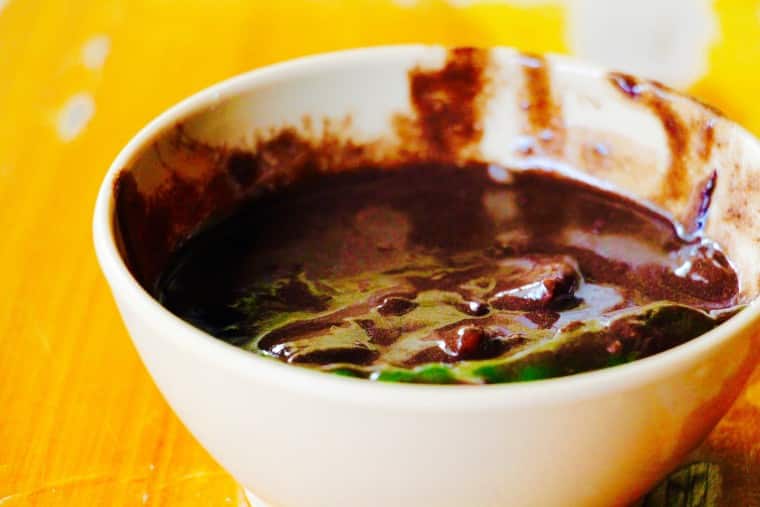
What are the origins of Dinuguan?
The origin of Dinuguan is not certain, but it is believed to have originated during the pre-colonial period in the Philippines. It is thought to have evolved from a traditional indigenous dish called “dinuguan” or “dinardaraan,” which was made with game meat and blood.
During the Spanish colonial period, pork became more widely available in the Philippines, and it is thought that the dish was adapted to include pork as the main ingredient. The dish has since become a popular and integral part of Filipino cuisine, and it is enjoyed by people of all ages. It is often served with rice or Puto, a type of Filipino rice cake.
Hold onto your hats, this could get messy. This is some intense and exotic Filipino food right here. This is top-self, hardcore food indulgence. Balut is a fertilized duck egg that is boiled and eaten in the shell. Balut is a popular street food in many countries in Southeast Asia, including the Philippines, Cambodia, and Vietnam.
Even for the most daring of eaters, balut is definitely an out-of-the-ordinary snack option. When and why did humans begin consuming fertilized duck eggs?
What is Balut?
But, what is Balut? Balut, often spelled as ballot is a fertilized developing egg embryo that is boiled or steamed and eaten from the shell. The word “Balut” comes from the Tagalog word “balot,” which means “egg.” In South China and other countries in Southeast Asia, particularly the Philippines, Cambodia, and Vietnam, it is a widespread practice to sell it on the street as a form of street food. Check that photo out, I told you this is hard-core street food.

The number of days that an egg must be incubated for before it can be cooked varies from region to region, although the average time is somewhere between 14 and 21 days before it is cooked and eaten. Balut is known for its unique flavour and texture, and is considered a delicacy. Yes, the partially-developed duck embryo inside the egg is visible. Have a look at that photo. How on earth can anyone on this planet think that is a delicacy? Not on my watch it’s not.

Vendors peddling these eggs on the street chant “Baluuuuut!” to entice buyers. Entice away my friend, you’re not selling one of those bad boys to yours truly.
What is the origin of Balut?
So, like many other peculiar Asian meals, it’s thought to have originated in China. Chinese merchants may have introduced Balut to the Philippines as early as the year 1885. The Chinese term for these eggs is “mao dan,” which means “feathered or hairy egg” in a literal sense.
The Chinese may have been the first to introduce Balut to the Philippines, but the Filipinos have made it their own by giving it a Tagalog name. The embryo is wrapped in a white film, hence the name “Balut,” which is derived from the word meaning “wrap.”
A low entry price point made balut a popular snack among the working class after it was widely distributed. Migratory patterns throughout Southeast Asia caused the snack to spread to new countries like Vietnam and Laos.
Why do people eat Balut?
It seems to be related to persistent misconceptions about a man’s sexual health. Yes, Balut has been promoted as a sexual enhancer. Balut may be eaten to stimulate libido, but its effectiveness in this regard is debatable; these days, it seems people eat it primarily for its flavour. Well, clearly it’s not eaten for its stunning looks.
It has been argued that Balut also has beneficial health effects. The protein content is substantial for such cheap food, at about 13.7 grams per egg. About 16.5 grams of protein can be found in 50 grams of beef jerky. Because of this in the Philippines, eating balut is suggested for pregnant women despite the fact that it has been linked to an increased risk of Salmonella for some.
How to eat Balut?
Where do you start when eating balut?
Find the egg’s rounded end and tap it softly on the table to crack the shell. Once the shell is split, peel it off to reveal a hole about the size of your finger. The egg needs to be seasoned after that, and the most popular options would be salt, vinegar, and chili peppers all of which the vendor should have on his/her stall.
Swirl the egg about with a spoon to incorporate the seasoning. Using the hole you made in the shell, gulp down the ‘soup’. When I say soup, I actually mean the rather strange liquid within. After consuming the soup (aka liquid), the remaining shell can be broken open to reveal the meat inside.
It is a popular practice to re-coat the meat in a combination of the seasonings before consuming it.
You’ll see the egg yolk, the egg white, and the chick. Yes the baby chick, with beak, feathers, feet, and all that.
The yolk has a velvety consistency and is usually the most sought-after portion of Balut. While the chick is favoured by others, it might have a quite crunchy beak and skeleton depending on the egg’s development stage (oh my goodness). Then finally to the white, often known as the Bato (Spanish for “stone”). It is edible but can be nasty for some individuals, as it is hard and very chewy.
So, I leave you to Balut. Your decision awaits. Dare you try it the next time you visit the Philippines? It is hard-core and truly one of the most exotic foods on the planet.
What is Betute?
The French may have turned frogs’ legs into a delicacy, but Filipinos take it to the next exotic food level. With Betute, they get a frog, stuff it with minced pork or beef, other savoury bits and bobs, and deep-fry it to be almost crispy frog-popsicle-style. Oh yes.
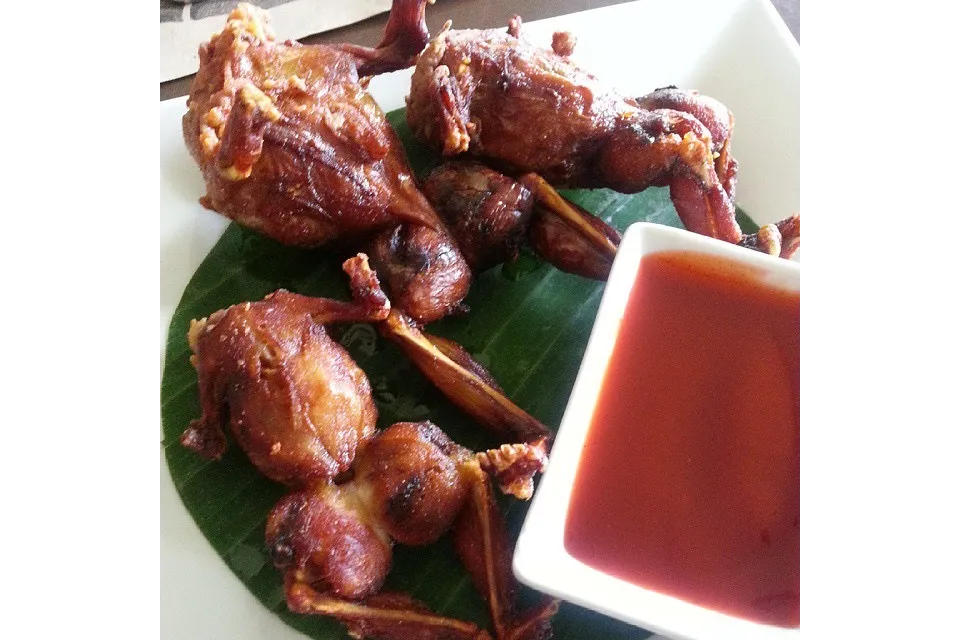
How to cook Betute?
Betute frogs are often stuffed with ground pork and vegetables, and then deep-fried until they are crispy. Betute is typically served as an appetizer or as a main course, and it is often accompanied by a dipping sauce or gravy. Betute is popular in the Philippines and is often enjoyed during special occasions or celebrations. It is also sometimes known as “Adobong Betute” or “Betute Tokwa” because the stuffed frogs are often cooked in an adobo sauce or served with tofu.
What’s the origin of Betute?
Some people believe that Betute originated in the Philippines, while others think it may have been influenced by other Southeast Asian or Chinese cuisines. It is possible that Betute was originally created as a way to use up surplus frog populations or as a way to make use of a readily available and abundant food source. Regardless of its origins, Betute has become a popular and distinctive dish in Filipino cuisine.
Frog has been a staple in Kapampangan cuisine for a very long time, and it can be found on the menu of any restaurant in the city, from the most upscale to the most modest establishments on the streets. So, I guess, there is no surprise that Betute is such a popular dish in the Philippines.
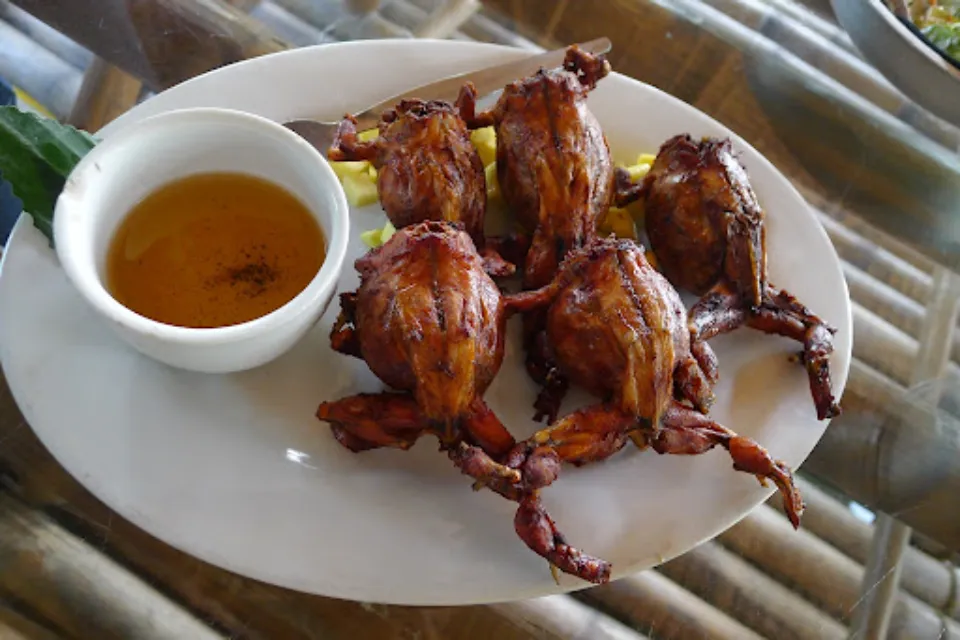
What is the Filipino food, Laing?
Laing is a Filipino dish made with Taro leaves, coconut milk, and meat or seafood. It is a traditional dish from the Bicol region of the Philippines and is often served as a side dish or as a main course.
How to cook Laing?
The Taro leaves are cooked in coconut milk and seasoned with spices such as chili peppers, garlic, and ginger. Meat or seafood, such as pork, beef, or shrimp, is often added to the dish to give it more flavour and protein. Laing is typically served with rice and is known for its rich, creamy, and slightly spicy flavour. Sounds kind of familiar to that Bicol Express or is it just me?
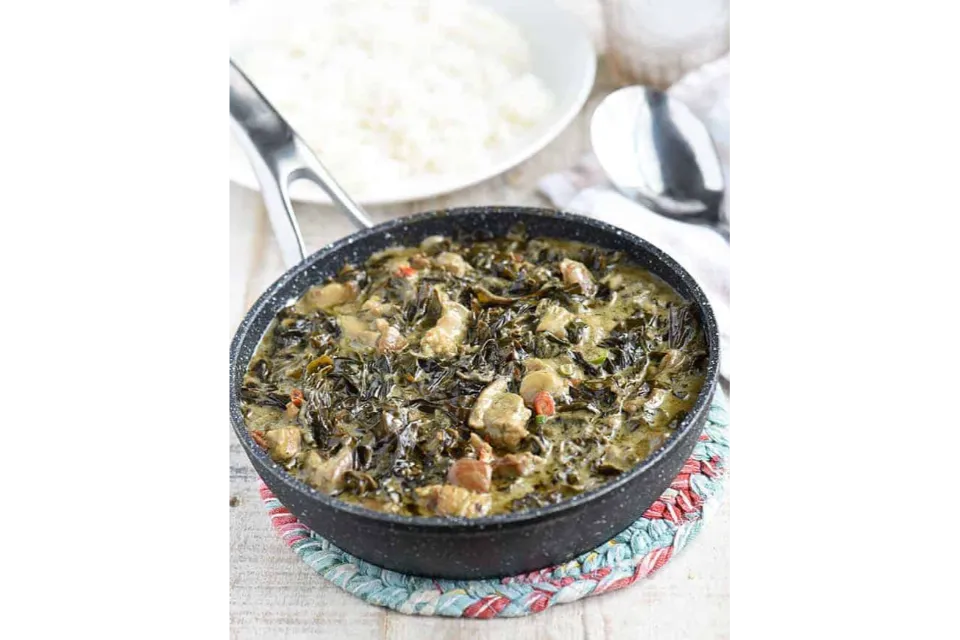
What is the origin of Laing?
The Filipino meal, Laing, is supposed to have originated from indigenous Bicolano people, who have a long history of using Taro leaves and coconut milk in their cooking. Taro is a staple crop in the Bicol region and has been cultivated there for centuries, so aligns with that theory methinks.
But, while it shares many components with the version eaten throughout the rest of the country, it is prepared quite differently. Instead of using shredded Taro leaves, as is done in most versions of Pinangat na Gabi, the traditional Bicolano Laing (also known as Pinangat na Gabi) uses entire leaves to create pouches around the pre-cooked meat or fish mixture, which are then steamed in coconut milk until fork-tender.

Laing is also popular in Manila, and is prepared in the same way, only the leaves are shredded before cooking. They also tend to include the stalks from the chopped leaves. Laing is typically served with white rice, but it can also be used as a stuffing for other foods. I wonder if this would go well with Betute?
Because of the presence of calcium oxalate crystals (raphides) in Taro leaves, proper preparation is required before they can be used for Laing. In order to prevent this, they are carefully washed before cooked. The amount of crystals can also be reduced through drying. If you don’t do this, the leaves can sometimes cause itching and burning sensations in the mouth.
What is the Pinakbet?
Pinakbet, also known as pakbet, is a traditional Filipino dish made with a mix of vegetables, often including bitter melon, eggplant, okra, and tomatoes. It is usually cooked with shrimp paste (bagoong) or fermented fish sauce (patis), and may also include meat, such as pork or beef. The vegetables are usually sliced or diced and then sautéed or stir-fried in a pan with the chosen protein and seasonings. Pinakbet is typically served as a side dish, but it can also be served as a main course with rice.

What’s the origin of Pinakbet?
Pinakbet is a dish that originated in the Ilocos region of the Philippines, which is located in the Northwest of the country. The Ilocos region is known for its abundance of vegetables and seafood, and Pinakbet is a reflection of the region’s culinary traditions.
The name “Pinakbet” is derived from the Ilocano word “pinakebbet,” which means “shrunk” or “shrunken.” This refers to the appearance of the vegetables in the dish, which are typically sliced or diced and then cooked down until they are tender. The dish is thought to have originated as a way for farmers to use up their excess vegetables, and it has become a staple of Filipino cuisine.
Pinakbet is a healthy, cheap, and easy-to-cook dish that has made its way around the archipelago. It is cooked in most households and local restaurants. Try it at Max’s Fried Chicken, Ayala Avenue Ground Floor, Convergys Building, Makati, Luzon Philippines.
What is Sinugno?
Cooking with coconut milk is common in the province of Quezon, south of Manila. For the Filipino dish Sinugno, freshwater Tilapia fish is grilled and then simmered in coconut milk, mustard leaves, and chili. Tilapia is a good choice for Sinugno because of the smokiness of its flavour when grilled, as this cuts through the sweetness of the coconut milk. When grilled, Tilapia releases a fragrant aroma and is incredibly delicate, making it one of the many fish species that simply bursts with taste and is seriously perfect for Sinugno.
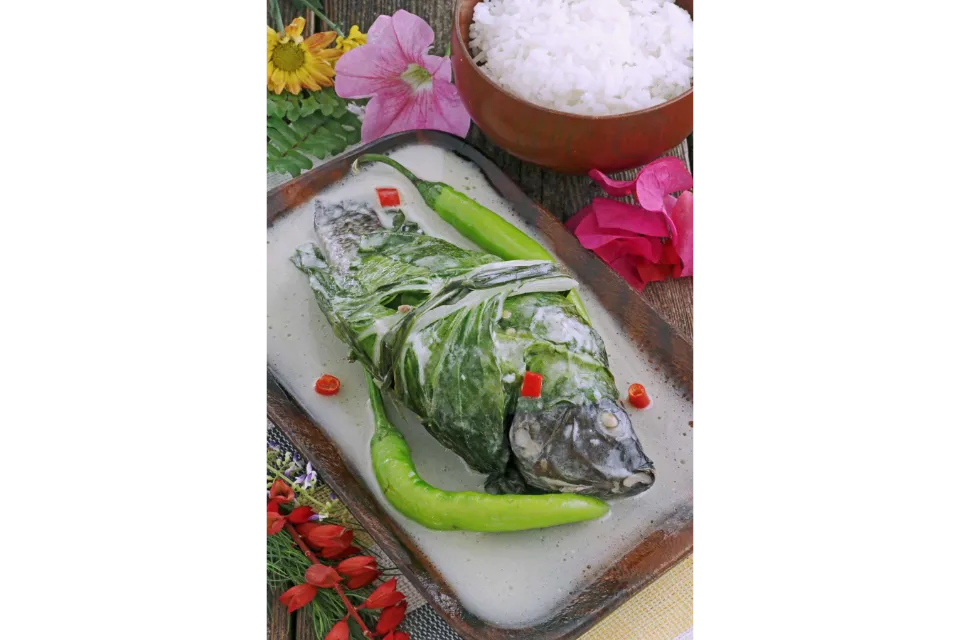
Where did Sinugno originate?
Since Quezon province is famous for its coconuts and coconut goods, it is not unexpected that the Sinugno recipe originated there. One may draw comparisons between this dish and Sinanglay, another Tilapia dish, based on the ingredients and methods used.
Sinugno is definitely freshest when eaten close to fishponds as they do in Kamayan sa Palaisdaan Hotel & Resort, Brgy. Dapdap, Tayabas City, Quezon Philippines. We even have ‘catch-to-table’ now in Bohol, at places like South Farm on Panglao. Literally, catch your Tilapia, and take it to the restaurant for them to cook up a Sinugno for you. Here’s my Jude Jude with his 3rd catch of the day at South Farm.

What is Bagnet?
Locally in Ilocano, Bagnet is known as “Chicharon,” and it is a Filipino delicacy made of pork belly (liempo) that has been boiled, air-dried and deep-fried (liempo) till crispy. Garlic, black peppercorns, bay leaves, and salt are used as seasonings for Bagnet. To achieve the meat’s signature Chicharon-like texture, it is cooked and then dried fully overnight before being fried.
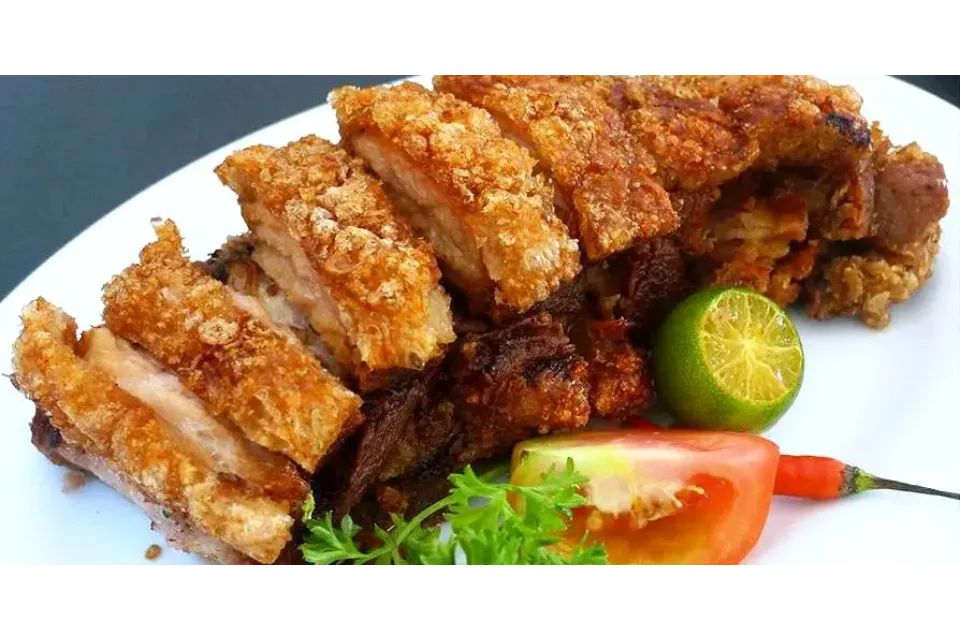
It’s very much like the Tagalog dish known as Lechon Kawali, this is what we have on Bohol. The main differences are in the origins of the ingredients, the method of preparation, and the cooking procedure. While I can’t say for sure, I believe that deep-frying the pork is to increase its shelf life, a practice passed down from generations past with no refrigeration.
You may also find Bagnet in Pinakbet and Dinardaraan, two more popular Filipino cuisines. To accompany Bagnet, vinegar (often Sukang iloko), bagoong (fermented fish or shrimp paste), or (less commonly) pig’s blood are common dipping sauces. Bagnet is truly coveted for its irresistible crunchy skin dipped in the sweet-sour vinegar Sukang Iloko. This is beer food on steroids my friends.
What are the origins of Bagnet?
Fry up some pork belly and you’ve got yourself some Filipino Bagnet. It’s one of the most famous meat dishes in the Philippines, and it comes from the province of Ilocos in the North. This should come as no surprise, seeing as how Bagnet is the delicious result of combining fatty pork belly with a deep fryer and a long, slow cooking process. Is there really anything that could top it? Well add an icy cold beer and you’ll top it for sure. A match made in heaven.
In the Filipino film, I’m Drunk, I Love You, Carson (played by Maja Salvador) develops a major hankering for Bagnet, and even choreographs an impromptu “Bagnet dance” in its honour. Maybe they’ll be a Fiesta in its honour next? Wait a minute, Narvacan, Ilocos Sur, is home to the annual “Bagnet Festival,” and is credited as the birthplace of Bagnet. Well, how about that
Buy it from the markets of Ilocos, or try it at Cafe Juanita, 2 United St Kapitolyo, Pasig, Luzon Philippines.
What is Pancit Habhab?
Trust Filipino ingenuity to adapt noodles to their lifestyle. In Lucban, Quezon, Pancit Habhab is served on a banana leaf and slurped. Pancit Habhab is garnished with carrots, chayote, and a few pieces of meat, this cheap noodle dish is most often eaten by students and jeepney drivers on the go. Yep, Filipino fast-food, literally.
How to eat Pancit Habhab?
Dried flour noodles, known as Miki Lucban, are the basis of Pancit Habhab. These noodles are not the same as the ones used in Pancit Canton, and they also don’t compare to the fresh, softer Miki noodles. This Pancit dish is traditionally eaten with one’s bare hands and is served over a banana leaf. How? Now, picture yourself enjoying a sandwich. You should take the noodle wrapper made of banana leaves and place it directly in your mouth. Though, you shouldn’t eat the banana leaf. Yes, this can get very messy, but such fun to eat.
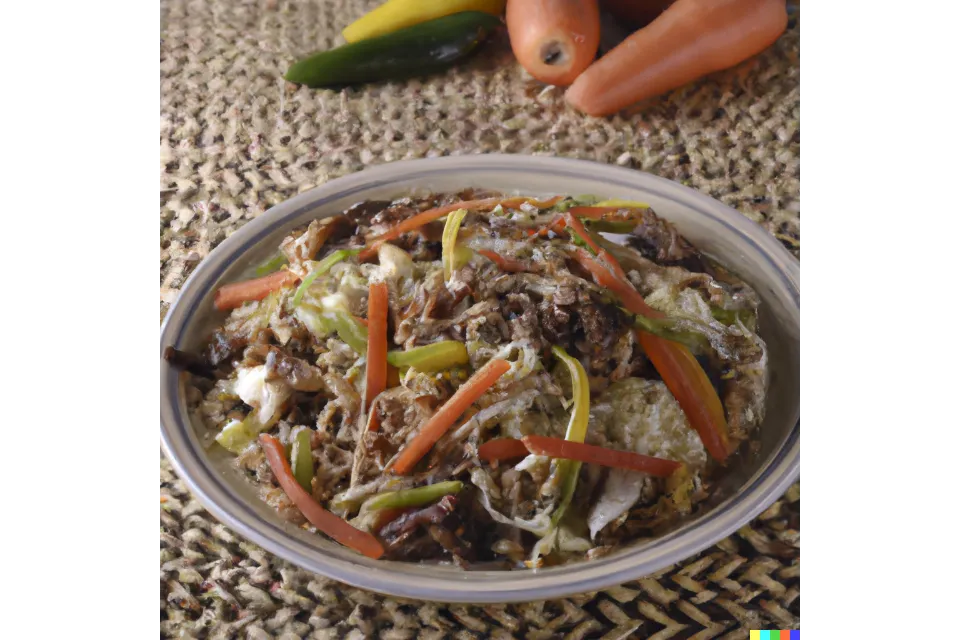
Why is it called Pancit Habhab?
It’s all linked to the eating method. Habhab is the term used by locals of the Philippines’ Lucban province to describe the custom of eating the region’s signature dish, Pancit, which consists of miki noodles, pork meat, liver, shrimp, vegetables, and a dash of cane vinegar, all served on a banana leaf and manipulated so that the dish is dumped directly into your mouth.
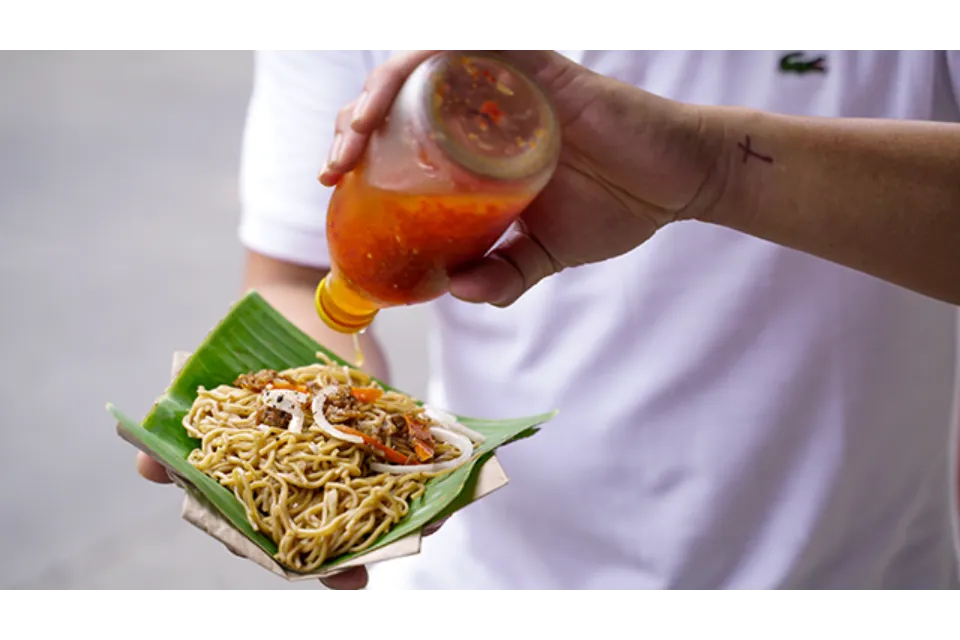
For an extra special version, there’s the Old Center Panciteria which has been making the noodles since 1937. Cooks there add lechon, a generous serving of vegetables, and even hand you a fork (yes, they do… now they need to change the name of the dish here haha). Visit them at 85 San Luis St. Lucban, Quezon.
Uok, or beetle larvae, may not sound delicious at first, but it is a popular exotic delicacy when prepared as adobo and eaten with rice and tomatoes. The Balaw-Balaw Restaurant in Angono, Rizal, is one of the places where you can chow down on this meal.
What is Uok?
I suppose, as long as the Salagubang (Beetle) is considered a delicacy by some, it stands to reason that Uok would be considered a gourmet item as well. Uok is the larvae of the coconut beetle and a common snack in the streets of the Rizal region. The fact that it’s an insect might not make it sound particularly tasty at first, but the people of the Rizal province swear by it. Uok is the creature that inhabits the hollowed-out coconuts. The locals gathered them and ate them, raving about the tasty and unique treat they found.
Nobody could have predicted that this strange-looking meal would become a favourite of not only Filipinos but even foreign visitors to the Philippines. Yes, tourists flock to get their teeth into Uok. It likely helped that the infamous TV show, Bizarre Foods with Andrew Zimmerman covered Uok on one of their episodes. Yes, he ate it, and no he didn’t like it. He quipped that they were characterized as having a sticky, earthy flavour.
Apparently, once you get over the notion that you’re eating a beetle larvae, the indigenous Filipinos say it has a pleasant texture and taste. Uok also provides a healthy dose of protein, so there’s a double-whammy for you. A great incentive to run down the shops and get your Uok order in. I promise I won’t be far behind you.
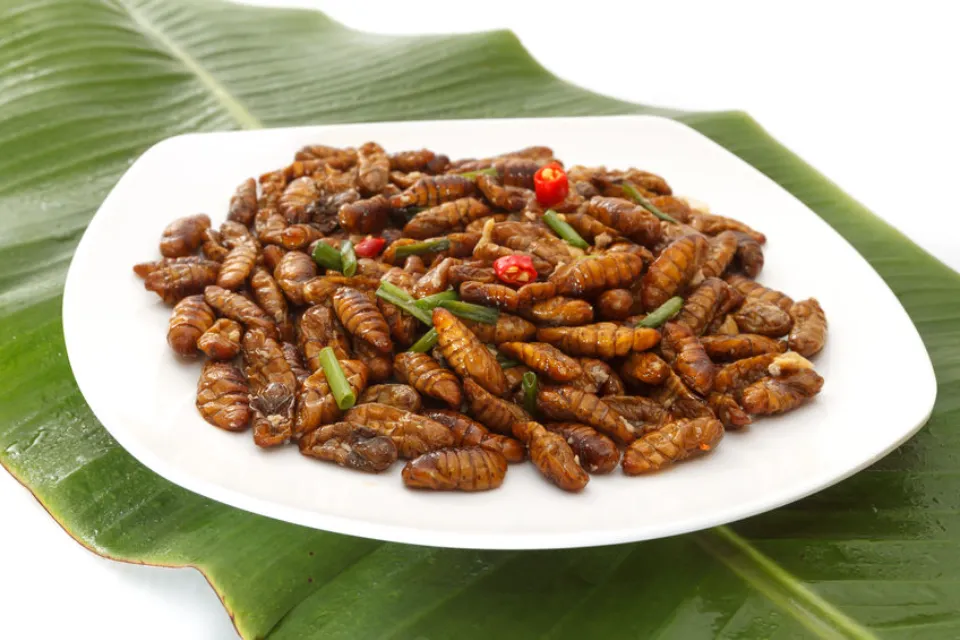
How to cook Uok?
Adobong Uok is another common preparation for this distinctive Filipino dish, just like Salagubang. Uok (indigenous name) refers to the larval stage of the Coconut Rhinoceros Beetle, which can be found in rotting coconut logs. It is possible to eat this fat, creepy worm raw, like the indigenous do in the jungle. Despite its worm-like appearance, this scary critter tastes finest when cooked in adobo manner and is then referred to as “Adobong Uok.” Popular all over the Philippines, this unusual cuisine is especially well-liked in certain regions.
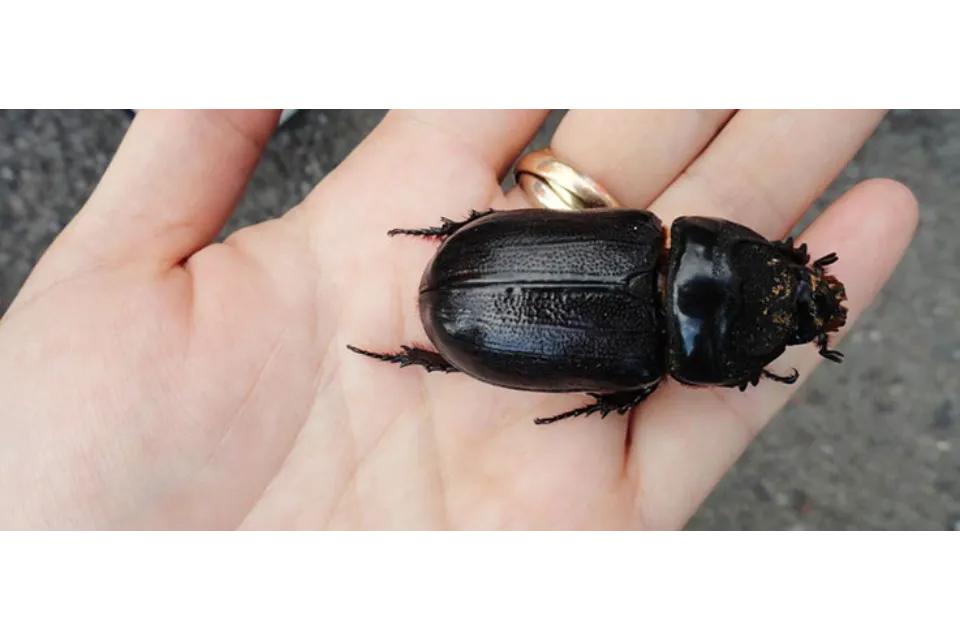
Adobong Uok is cooked with vinegar, soy sauce, and pepper. It is not eaten in an ordinary way. Of course, why would it, this is the Philippines. Of course you have to remove the head first before sipping the inside of it. To do anything else would just be ridiculous. It really is more fun in the Philippines.
What is Longganisa?
Filipino Longaniza is a type of Spanish sausage that is popular in the Philippines, rebranded to Philippines cuisine as Longganisa. It is made from ground pork and is seasoned with a mixture of spices and flavourings, such as garlic, vinegar, paprika, and sugar. The sausage is typically shaped into a long, thin link and is then smoked or grilled. Longaniza AKA Longganisa is often served as a main dish, either on its own or as part of a larger meal. You can also just snack on this with icy cold beer. It is a staple in many Filipino households and is enjoyed by people of all ages.

Every province has its version of the pork sausage called Longaniza. It varies from sweet to garlicky to spicy and usually gets consumed for breakfast with garlic rice, fried egg, and a dipping sauce of vinegar. Named for the city or province of origin, these variations are easily distinguishable. Sweet Longganisa is Hamonado, and garlicky, sour, and salty Longganisa is Derecado.
What are the origins of Longganisa?
Filipino Longaniza has its roots in Spanish cuisine as we explained before. Sausages similar to Longaniza have been made in Spain for centuries, and it is believed that the recipe for Longaniza was brought to the Philippines by Spanish colonizers in the 16th century. The recipe for Longaniza has then evolved over time to make similar, but unique versions to the Philippines region by region with their Longganisa.
Just look at the two photos of Longganisa to see the difference in the sausage stuffing.
Also, Longganisa is a ‘style’ of Chorizo, which is equally popular in Philippines cuisine.

Lumpiang Ubod
What is Lumpiang Ubod?
The Filipino appetizer known as Lumpiang Ubod is made by rolling julienned Ubod (heart of palm) and other ingredients including meat and vegetables in an extremely thin egg crêpe. Even though it is most often served fresh, it can also be deep-fried. It was first made in the city of Silay in Negros Occidental, and today you can still find the original version of the dish known as Lumpiang Silay.
Lumpiang Ubod is typically served as an appetizer or a snack and is often accompanied by a dipping sauce made from vinegar, soy sauce, and chili peppers. The fruit, leaves, and even the pith of the coconut tree are used in Filipino food, so no surprise that the palm heart is in use here.
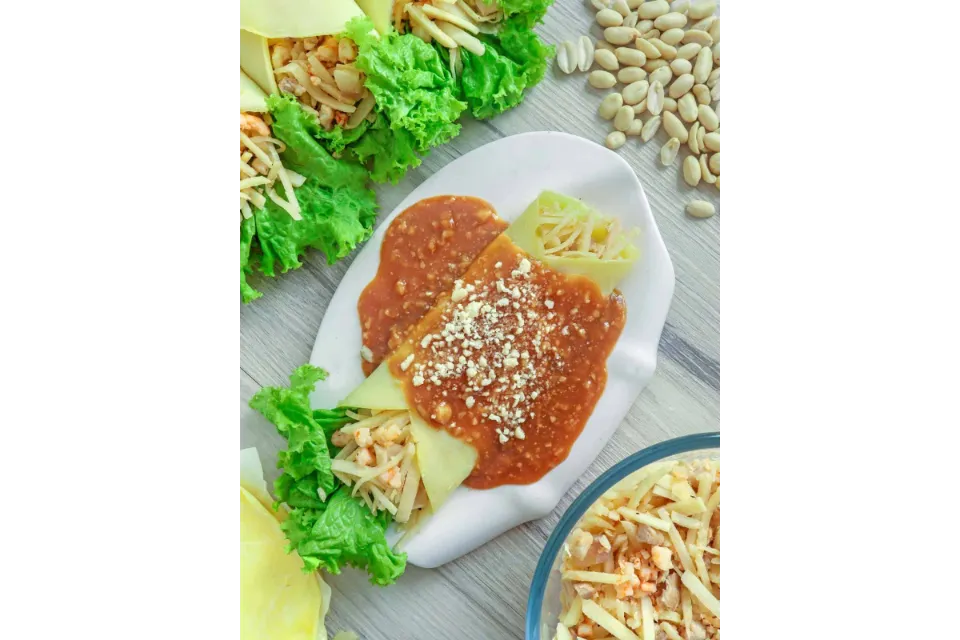
What’s the origin of Lumpiang Ubod?
It is said that it first appeared as one of the appetizers served on woven trays (bilao) by servers (manuglibod) in Mahjong gambling dens frequented by the city’s affluents. Ubod comes from newly cut coconut palms, another common ingredient in Ilonggo dishes. As it gained popularity, it was adopted in various parts of the Philippines and began to take on the traits of the more common Lumpiang Sariwa.
Lumpiang Ubod are also an adaptation of the Fujianese pokiah, a type of spring roll made of thin, paper-like crepe or pastry wrapped around a savoury or sweet filling. They’re popular in Indonesia as street hawker food and in the Philippines as a midday snack or appetizers for parties and special gatherings, or with icy cold beer (my favourite option).
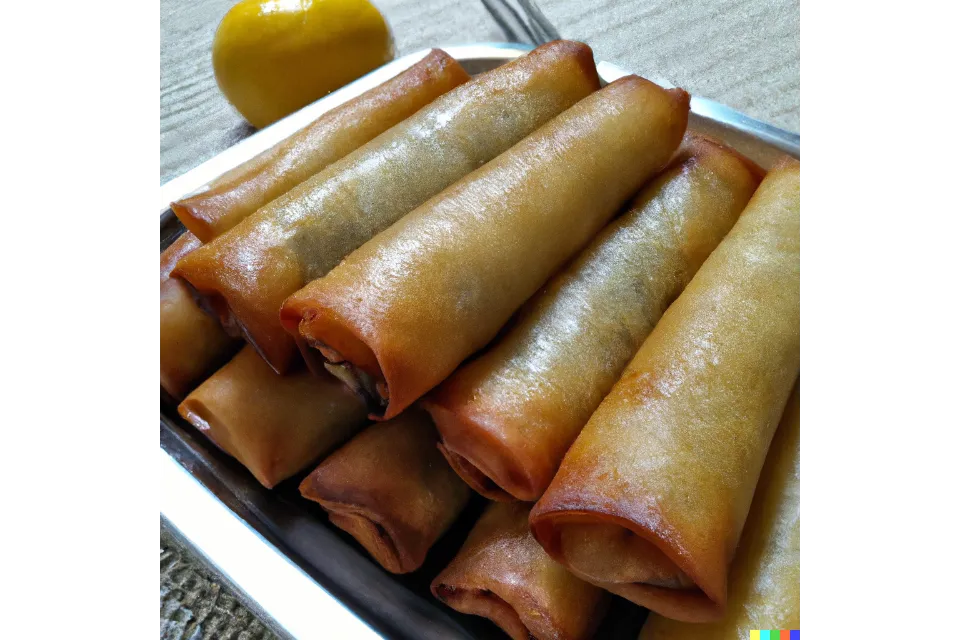
Bacolod city is known for its petite version of this spring roll, and you can try that at El Ideal, 118 Rizal Street, Silay City Philippines.
Bicol Express
What is Bicol Express?
One of the most well-known Filipino dishes, without a shadow of a doubt, is Bicol Express. This is due in no small part to the spicy kick that this meal delivers. Bicol Express is a fitting tribute to people who love coconut and spicy food, because it is a fiery chili, pork, and coconut milk stew.
What are the origins of Bicol Express?
Invented on a fast passenger train that runs between Bicol and Manila. The name of that train is…? Yep, you guessed it, the Bicol Express. It is believed to have been created by a chef who worked on the train.
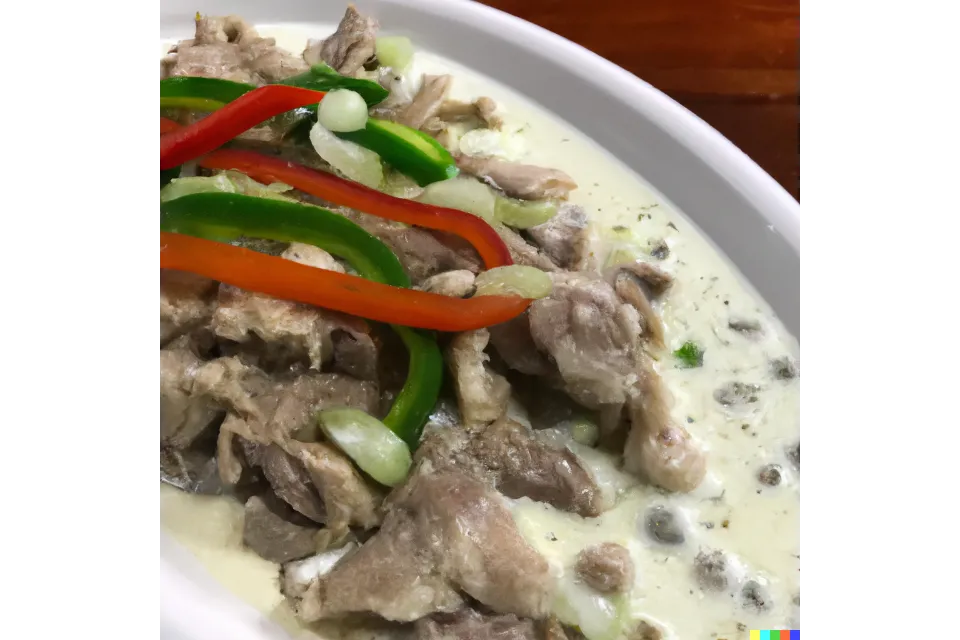
How to cook Bicol Express?
It is made from pork belly or pork shoulder that is cooked in coconut milk, shrimp paste (bagoong alamang), and chili peppers. Bicol express is typically served with rice and is enjoyed as a main dish. It is known for its spicy, salty but sweet, deep savoury flavourful taste, and is a majorly popular choice among Filipino food enthusiasts. It is a belter of a dish, and I am now a shrimp paste lover.

Bicol Express Recipe
I even had a try of making my very own version of Bicol Express. So you can now have a go at your own dish using my Bicol Express Recipe. Excuse the photo quality. This was taken an age ago.
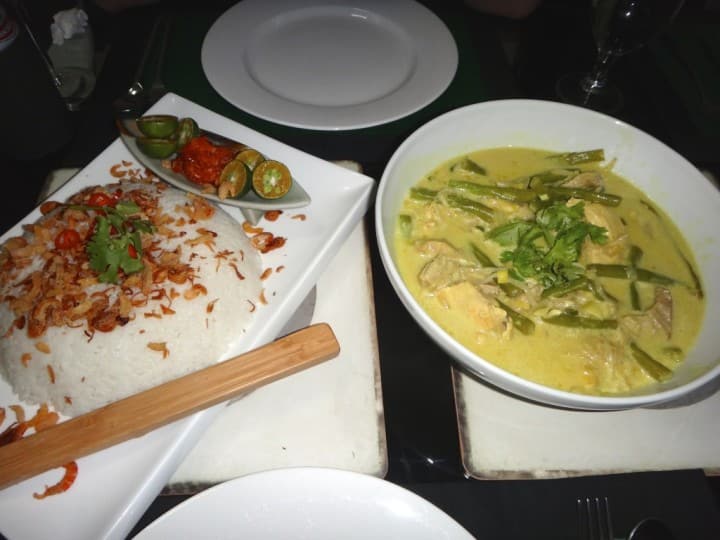
If you are in the Philippines why not try Bicol Express at the hole-in-the-wall eatery called Top Haus in Makati, 5994 J.D. Villena St., corner Mabini Street, Poblacion, Makati.
Kinilaw
What is Kinilaw?
Kinilaw, which literally means “eaten raw,” is a Filipino seafood dish and actually the technique of preparation. Because of its resemblance to the Latin American cuisine ceviche, it is also known by the name of Philippines Ceviche. Because it can be used to prepare both meat and vegetables, Kinilaw is more correctly described as a method of cooking that uses vinegar and acidic citrus fruit juices rather than a dish in and of itself.
The acid in the vinegar or citrus juice denatures the proteins in the fish, causing it to turn opaque and firm, similar to the way that heat cooks fish or other ingredients.
That, I find interesting as I always thought Kinilaw was just a fish dish in the Philippines. Dishes prepared in the Kinilaw style are typically served as starters before the main course or as pulutan (finger food) with cocktails, I am liking Kinilaw a lot as I love a cocktail. Fish Kinilaw is typically made with fresh, firm-fleshed white fish such as Tangigue, Snapper, or even Cod.
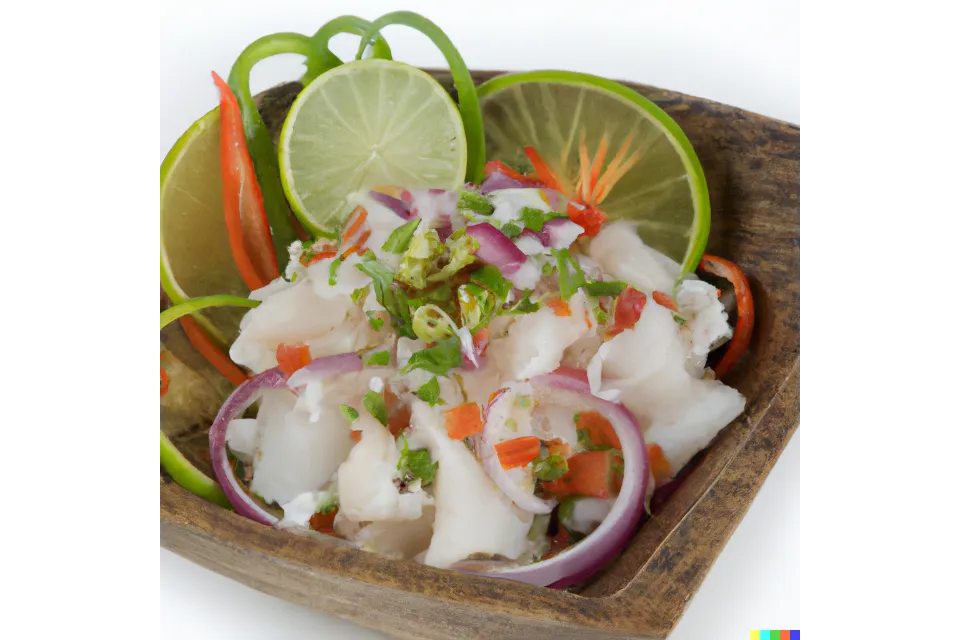
How to make Kinilaw?
To make Fish Kinilaw, the fish is cut into small pieces and mixed with vinegar or citrus juice, along with chopped onions, tomatoes, and chili peppers. The mixture is then seasoned with salt and sometimes other herbs and spices, such as ginger or garlic. The dish is typically served chilled, garnished with chopped fresh herbs or cucumber slices. Vinegar is the liquid fire that cooks the main ingredients. Aside from fish of all shapes and sizes, seafood like crabs, clams, shrimp, oysters, squid, sea urchin, abalone, and scallops can be used as main ingredients.
Meats like goat, beef, carabao, hog, and chicken are commonly used in the Luzon-centric variations of Kinilaw (typically referred to as Kilawin to differentiate them from other Kinilaw). Meat Kilawin, in contrast to Fish Kinilaw, is often cooked through, either by boiling or grilling. In addition, Papat (meaning “bittering agent”), either bile taken from the gall bladder or by squishing chewed grass from an animal’s stomach, is customarily eaten with meat-based Kilawin.
I don’t think I’ll be following the latter recipe and ingredients, but you can click here for our very own Beef Carpaccio Recipe.
Being slightly more adventurous with your meat choice, how about trying our Venison Tartare Recipe.

Each province will likely have its own way of preparing its version of Kinilaw. Most popular in Cebu is to eat it in Su-tu-kil, a long row of seafood eateries at Lapu-Lapu City, Mactan, Cebu.
Kuhol Sa Gata
What is Kuhol sa Gata?
Kuhol sa Gata is a Filipino dish made with snails cooked in coconut milk. It is a traditional dish in the Philippines and is often served as an appetizer or a snack, but it works well with hot rice.
How to make Kuhol sa Gata?
To make Kuhol sa Gata, snails are cleaned and boiled in salted water until they are tender. They are then cooked with coconut milk, garlic, onions, and a variety of spices, such as bay leaves and black pepper. The dish, Kuhol sa Gata, is loved for its rich, flavourful taste. The snails are served in the shell with a tiny fork (or toothpick), and the tips of the shell are also snipped off to loosen the meat inside during cooking. Are these the French escargot of Philippines cuisine?
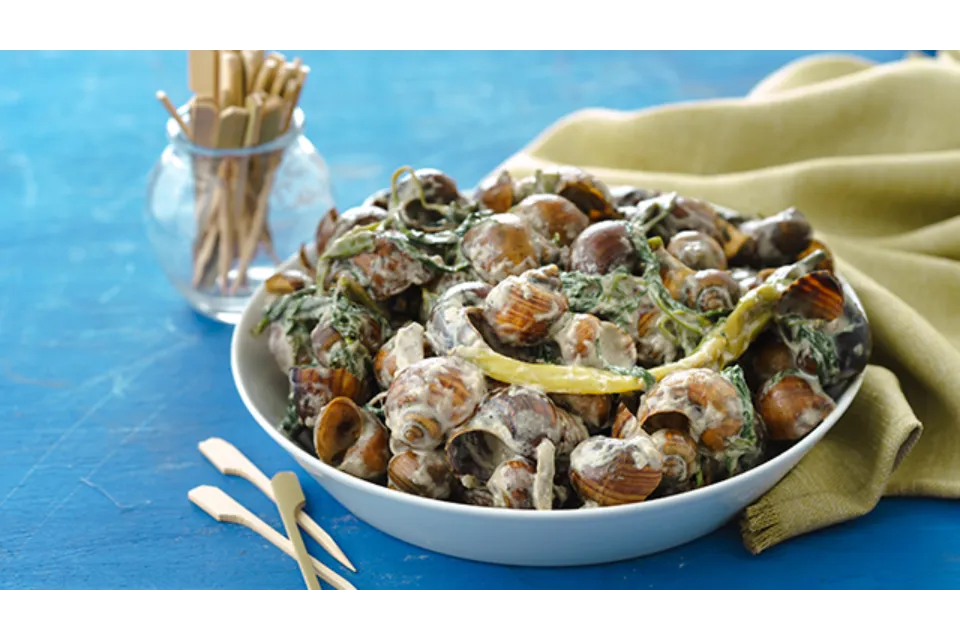
Every time a dish with Kuhol or snails is mentioned in Filipino cooking, a Ginataanng or a coconut cream sauce is the first one that comes to mind. So sometimes Kuhol sa Gata is also known as Ginataang Kuhol. Hotter versions of Kuhol sa Gata often include Labuyo chilies. There are many options for the versions with fresh greens added in, but some common ones are water spinach, Moringa leaves, and chili pepper leaves.
What is the origin of Kuhol sa Gata?
In the Philippines, snails are commonly found in rice fields and other wetland areas, and have been a staple food for some communities. The use of coconut milk as a cooking ingredient is also common in many Filipino dishes, as coconuts are widely cultivated in the Philippines. It is likely that the combination of snails and coconut milk in Kuhol sa Gata is a result of the availability of the two commodities together, and the nose to tail style of eating in the Philippines.

The apple snails native to the Philippine islands are members of the genus Pila. In most of the Philippines, you’d call these Kuhol (also Kohol or Cohol), however in the North-western portion of Luzon they’d be called Bisokol (or Bisocol). These snails are regarded to be among the worst 100 invasive alien species in the world.
From 1982 to 1984, Golden Apple Snails were introduced to the Philippines from bred specimens in Taiwan. They were released into the wild after they escaped from a farm where they were being raised for human and domestic duck consumption. They have developed into a serious problem in rice fields around Asia, especially in the Philippines. Eat on my Filipina buddies, eat on.
A recipe for Kuhol sa Gata
When making Kuhol sa Gata, they sauté garlic, onions, and ginger (or turmeric) until they are translucent and fragrant. The snails are then added and cooked for one minute before the remainder of the spices and thin coconut milk are thrown in. About ten minutes are spent simmering it on low heat. Last but not least comes the leafy greens, along with some (optional) coconut cream. The broth is ready when it has been reduced to a thick sauce. The cooked snails can be additionally flavoured with lime, butter, and shallots or leeks.
It actually sounds rather delicious, and by eating them you are saving the Philippines from an invasive species. Double-whammy.
Sinanglay
What is Sinanglay?
Sinanglay is a traditional Filipino dish originating from the Bicol area, that is made with fish that has been deboned and stuffed with a mixture of vegetables and spices, then wrapped in banana or Pechay leaves (similar to bokchoy), which helps keep the fish together and adds a peppery taste. The wrapped fish is then grilled or baked. The name “Sinanglay” comes from the Tagalog word “sanglay,” which means “to wrap.” The dish is typically made with Milkfish or Tilapia, but other types of fish can also be used.
Most Bicolanos love cooking anything with coconut and chillies. You’ll see a few of our 38 Unbelievable Filipino Food choices that originated in Bicol having those ingredients as a common theme in the ingredients list.
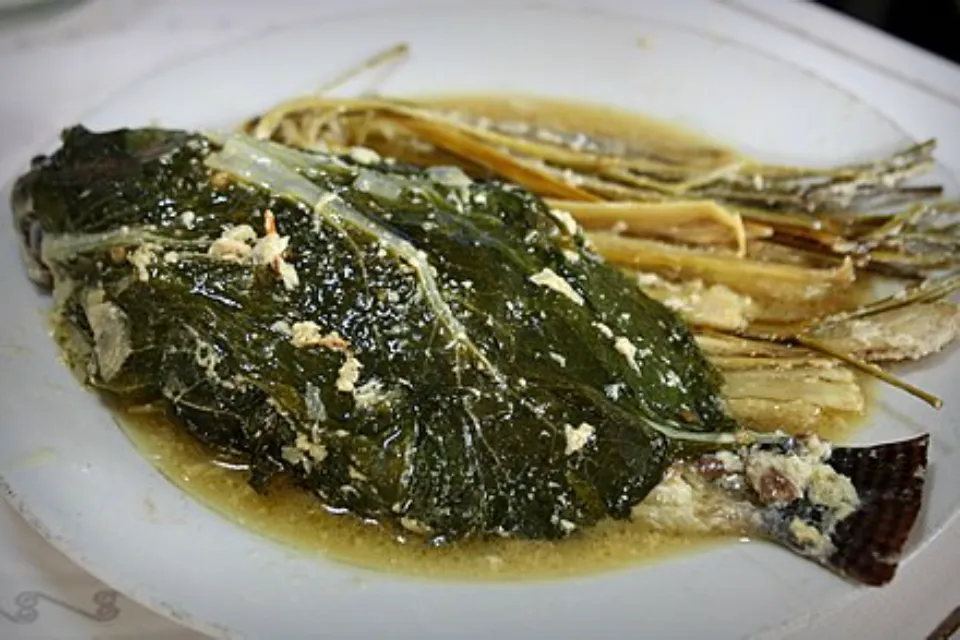
How to make Sinanglay?
It’s quite a simple dish Sinanglay. The fish is stuffed with a flavourful array of herbs and veggies. Onions, scallions, garlic, tomatoes, and Siling Haba peppers are common ingredients in the filling. Then, pandan leaves or lemongrass are used as ties after being wrapped with Pechay, mustard greens, taro leaves, or cabbage. Coconut milk or coconut cream, ginger (or turmeric), black pepper, fish sauce (Patis) or shrimp paste (Bagoong Alamang), salt, Labuyo chilies, and a souring agent are the base of the dish (usually tamarind, calamansi, or bilimbi).
Ten to twenty minutes, stirring occasionally to prevent the coconut milk from curdling, is spent simmering the dish. Sometimes shrimp or prawns are added to dishes to improve the Sinanglay flavour. It goes well with plain old white rice, go figure that in the Philippines.
Empanada de Kaliskis
What are Empanada de Kaliskis?
The literal translation of Empanada de Kaliskis is scaly pie, a traditional meat pie from Malolos. The Empanada de Kaliskis of Malolos, Bulacan is well-known for its delicious super-flaky crust, which takes on the shape of fish scales when deep-fried and cooked perfectly. With every crisp mouthful, you’ll discover a delectable chicken stuffing.
Empanada de Kaliskis is a specific type of empanada that is native to the Kaliskis region of the Philippines. It is made by stuffing a dough pocket with a filling that typically includes a combination of meat, vegetables, and spices. The empanada is then baked or fried until it is golden brown and crispy. Empanada de Kaliskis is often served as a snack. Looking at the photo below I’d buy a massive bag of these and a case of icy-cold Pilsens and go sit and much, drink and people-watch.
How to make Empanada de Kaliskis?
The chicken is boiled until it is tender, and then pulled apart, one strand at a time, taking care not to break the skin or shred the meat. The flavourful empanada filling is made by stir-frying these chicken strands with potato pieces, bits of chile, sugar, and pepper. Then laid carefully on the empanada wrapper before deep-frying them until golden-brown and crispy. Man oh man they look so good. I am thinking of booking a flight right now. These are on my must-have list.
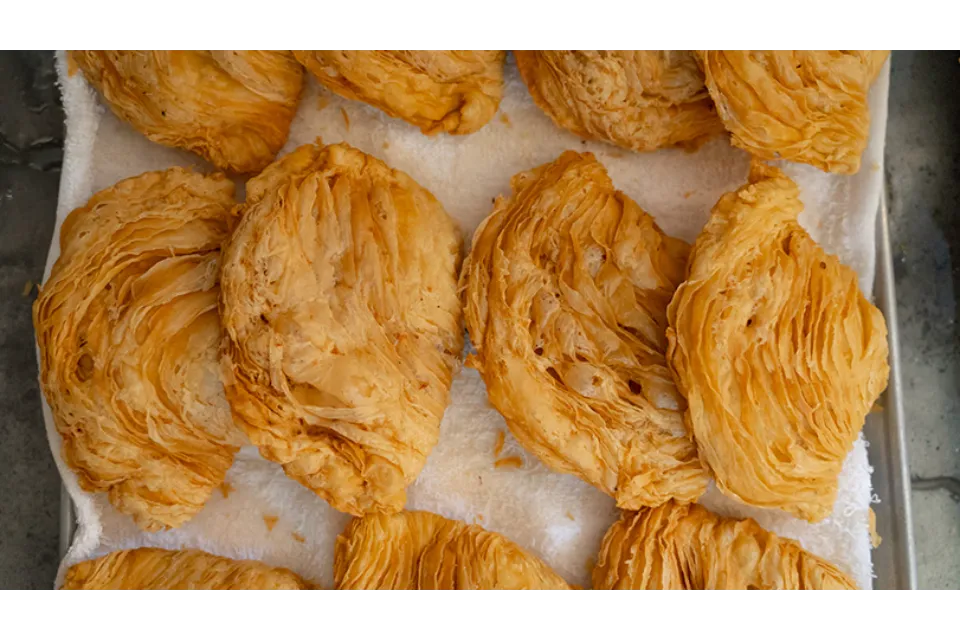
What are the origins of Empanada de Kaliskis?
Empanada de Kaliskis are best consumed when freshly made. If you happen to be in the Philippines, get it when in Malolos at one of the few remaining empanada makers in the Philippines, Mercy’s Empanada de Kaliskis. The narrow lanes of Malolos are home to Mercy’s Empanada de Kaliskis, a charming little business. There aren’t any major signs pointing to their shop, but if you ask around, you should be able to find it. Their recipe has been in use since 1820, making it 202 years old.
Malolos can rest easy knowing that the Empanada de Kaliskis will be around for years to come thanks to the efforts of both older and younger generations of women who are committed to carrying on the city’s culinary traditions.
Man, I love an empanada. I recently did a Mexican-themed BBQ and freshly baked Empanadas with a Filipino twist were on my menu, and were a massive hit. I served them on spoons with some home-made Sriracha on top. Anyways, back to the Philippines and these wonderful Empanada de Kaliskis.

Camaro Rebosado
What is Camaro Rebosado?
Camaro Rebosado is a Filipino dish made with prawns or shrimp that have been coated in a batter and deep-fried until crispy and golden brown. The name “Camaro” is the Tagalog word for prawn or shrimp, and “Rebosado” means “coated” or “breaded.” Camaro Rebosado is typically served as a snack or appetizer, and is often accompanied by a dipping sauce or condiment, such as a tomato-based sweet and sour sauce for dipping
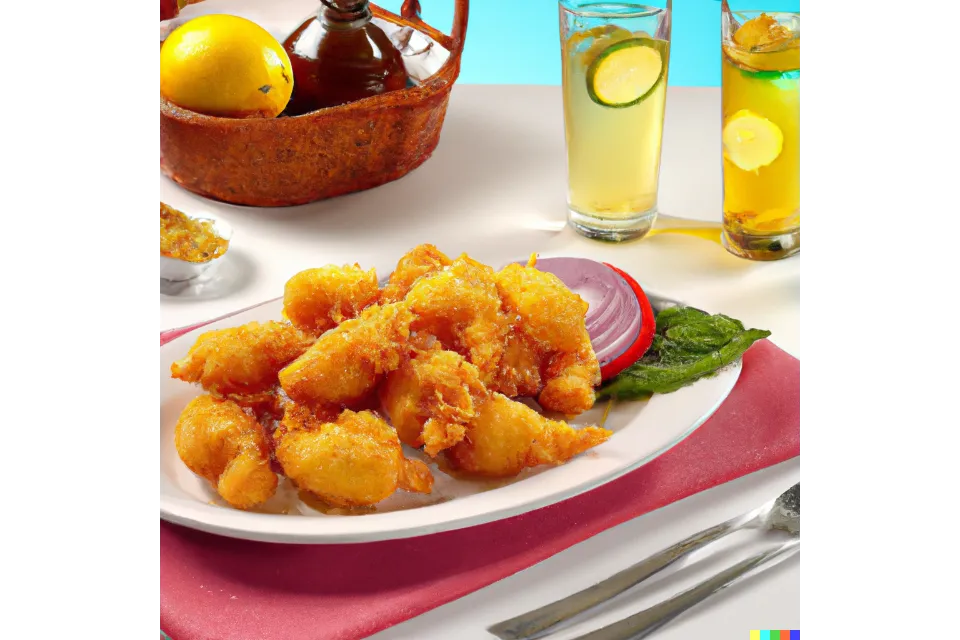
How to cook Camaron Rebosado?
Camaron Rebosado (translated in English as Overflowed Shrimp) is an easy seafood dish that makes use of shrimps or prawns as the primary component. Shelled shrimps are marinated in lemon juice and then coated with a batter made from egg, flour, and cornstarch before deep frying. This style of cooking shrimp nearly resembles the Japanese tempura, shrimp croquettes, and even Italian scampi; however, some ingredients and preparation steps vary.
What are the origins of Camaro Rebosado?
Camaron Rebosado derives its name from the Spanish words camarón (meaning “shrimp”) and rebosar (meaning “to boil”) (originally “bubble over, overflow”, but meaning “battered” in Tagalog). While it may have a Spanish name, the meal was really brought to the Philippines by Chinese immigrants, therefore it is technically Chinese Filipino.
One variant of this meal gets some meat in the mix too, Camaron Rebosado con Jamon. This is made by wrapping ham slices (Jamon) around the shrimp before coating them in the batter. Binondo is Manila’s Chinatown, and this cuisine has deep roots in the culture of that neighbourhood.
Bibingka
What is Bibingka?
Bibingka is a very traditional Filipino dessert made with glutinous rice flour, coconut milk, and sugar, which is baked in a clay pot lined with banana leaves. The Bibingka is often infused with flavours such as coconut, pandan, or ube (purple yam). Bibingka is typically served hot and is often garnished with butter, grated coconut, and/or cheese. It is a popular dessert in the Philippines and is often sold by street vendors or at special occasions and celebrations, such as Christmas and New Year’s Eve.
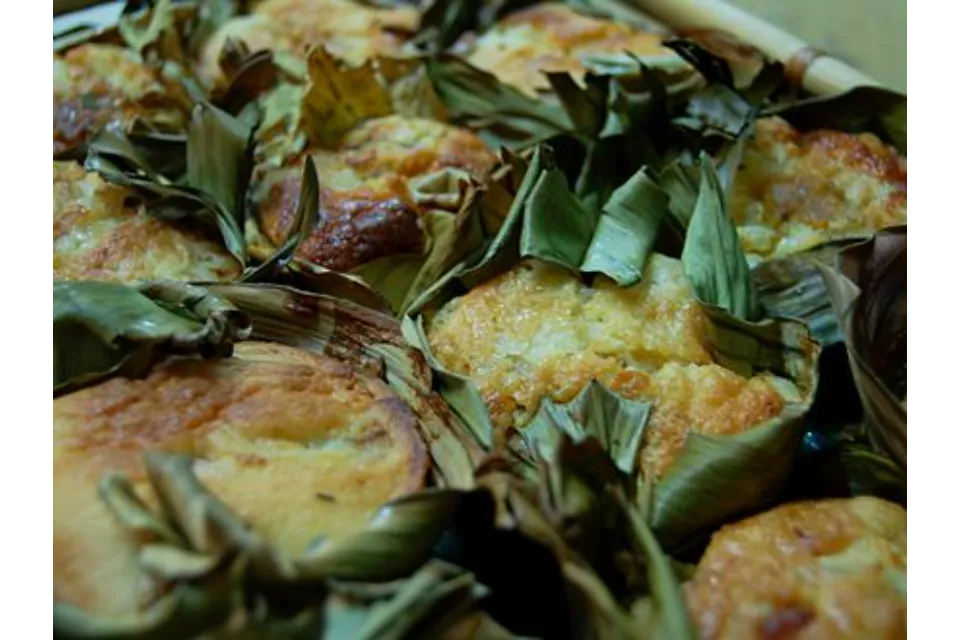
How to make Bibingka?
For many Filipinos, Christmas is marked by the scent of Bibingka cooking at dawn. These rather delicious rice cakes are made by soaking the rice overnight, grinding it with a mortar stone and mixing in coconut milk and sugar. Yes, it is laborious and a labour of love, akin to sourdough making.
The batter is poured into clay pots with banana leaves, with coals on top and below. It’s garnished with salted eggs, Kesong Puti (white cheese made from Carabao’s milk) and slathered with butter, sugar and grated coconut. Bibingka is absolutely best eaten hot from weekend markets.
The primary ingredients of the Bibingka are rice flour mixed with water to form a creamy batter. Coconut water can replace ordinary water to add a distinct flavour. To make the cake softer and richer, milk and eggs can be added, along with some brown sugar to make the cake sweet. Modern versions even contain small amounts of butter to give texture and richer flavour.
The batter is poured into large ‘muffin’ containers that have been coated with banana leaves, making it easier to remove the Bibingka when cooked. The banana leaf also exudes an aroma that the rice cake absorbs when it bakes. The ovens are preheated with coals underneath before the muffin containers are placed on the surface. The containers are then covered with a sheet of the banana leaf before a second basket of heated coals is placed on top of it.
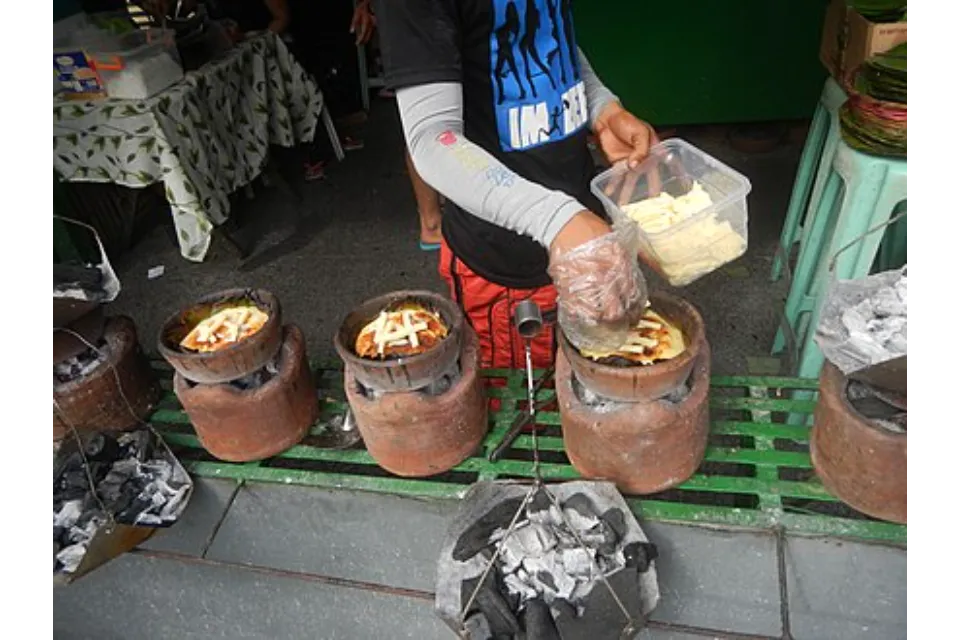
Filipinos eat a wide variety of rice cakes, and Bibingka is just one of them. The sweetness is balanced with a hint of saltiness in the background of the flavour. The texture of this rice cake varies from spongy to sticky depending on the recipe. Like other meals made with rice or rice flour, it can be classified as a “kakanin.”
What are the origins of Bibingka?
Although its background and etymology are unknown, the word “Bibingka” sounds somewhat like the Indian word for desert, “bebinca.” In contrast to the traditional Filipino rice cake, this pudding is made with a variety of pudding layers that are baked separately before being assembled into the final product. Although the ingredients are different, the process of preparation is the same, as both meals benefit from having heat applied from above and below when baking. The word “bi,” which means rice in Chinese, is also reflected in the bibingka name.
Suman at Manga
What is Suman at Manga?
Suman at Manga is a traditional Filipino dessert that consists of glutinous rice cakes (suman) served with a side of ripe mangoes (manga). Suman is made by steaming glutinous rice with coconut milk and sugar until it is soft and sticky. The rice is then shaped into small, cylindrical cakes and wrapped in banana leaves. Suman is typically served with a side of ripe mangoes, which are a popular fruit in Philippines cuisine, hence the name Suman at Manga.
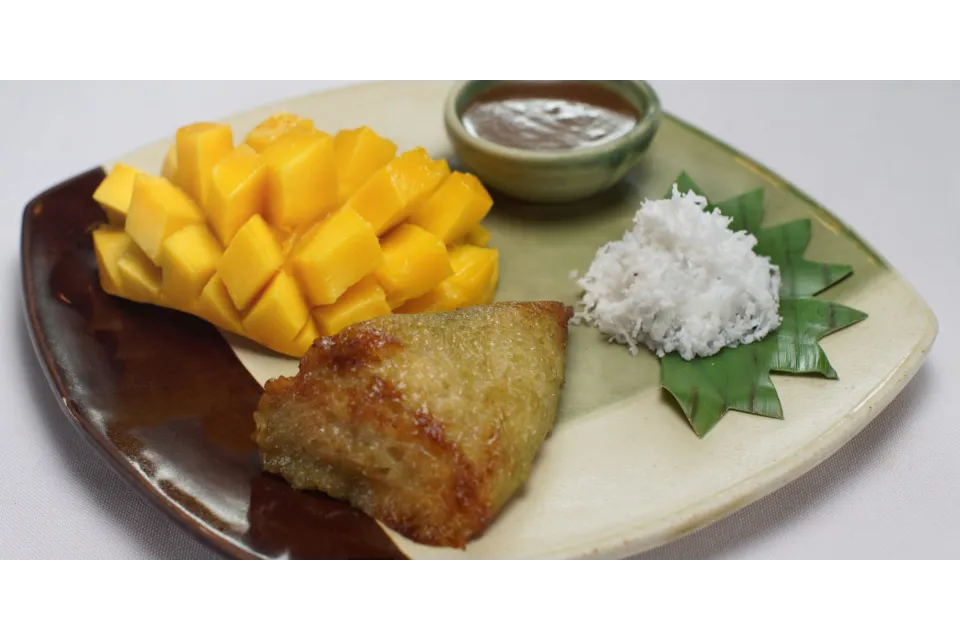
Way before Thai restaurants served the popular sticky rice and mango dessert, Filipinos have been eating suman with cashews and mango. The suman can be cosmopolitan or it can be rural. It can be eaten alone or as a celebratory dish in a fiesta. Some even hold this in such high regard that it should overtake Adobo as the Filipino National Dish, citing the fact that Filipino Muslims can’t eat pork, but all eat rice. Plus, add to that Mango is the Filipino National Fruit. Kind of makes sense actually.
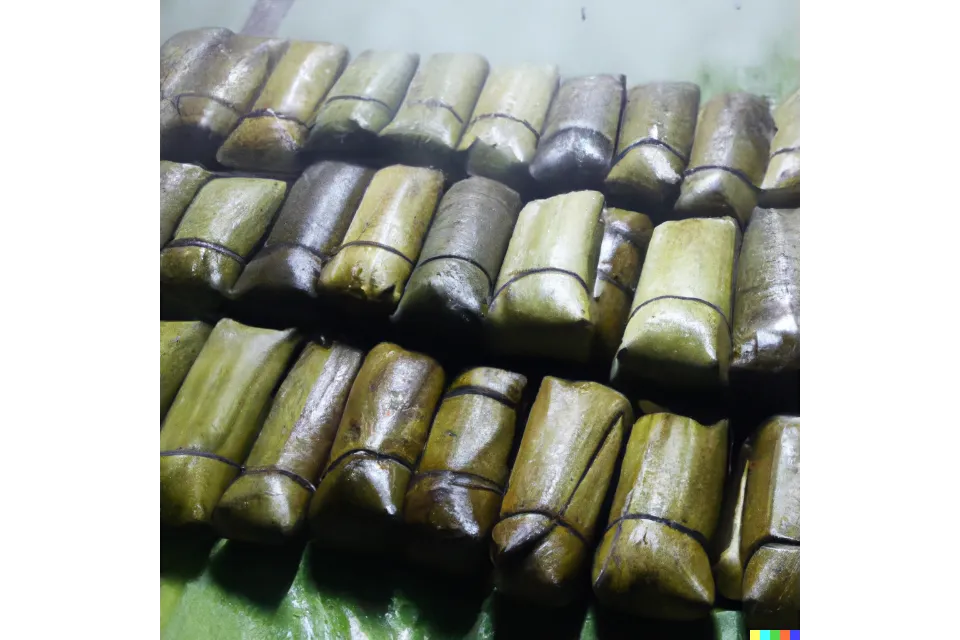
Suman at Manga get sold along the roadside at stalls and even enterprising vendors peddle them on buses and jeepneys. That’s when you get the version above, wrapped up in pandan or banana leaves. There are many versions of suman, depending on the ingredients and leaves used, but what unifies all of these would be the chewy texture and mild starchy flavour of the rice cake. Suman at Manga are cheap snacks, which travel well; sort of a Filipino native fast food.
What are the origins of Suman?
Suman is a rice cake originating from the Philippines. Filipinos have been making the Suman since pre-Colonial times. They offer it to the gods and as presents to visitors. It has been believed by Filipino rice-farming ancestors that there is nothing better to fill the stomach than rice, grown by farmers with much perseverance and hard work.
Filipino women telling stories while wrapping Suman has also been an appreciated sight in the Philippines and is considered part of the very colourful and vibrant culture of the country. I suppose it was a very early form of packed lunch for the farmers. Similar to the British Cornish Pasty, pastry-covered meat and veg for the miners to take to work for their snack break.
Champorado
When the rains start pouring and classes are suspended, children love this comforting breakfast. Champorado is a chocolate rice porridge. My wife is indeed, at age 45, one of those children. Whenever we stay in the Philippines at a hotel, the first thing she dashes for at the breakfast buffet is dried fish with Champorado. It’s hot, rich, and filling, and the dried fish offsets the sweetness (so she tells me).
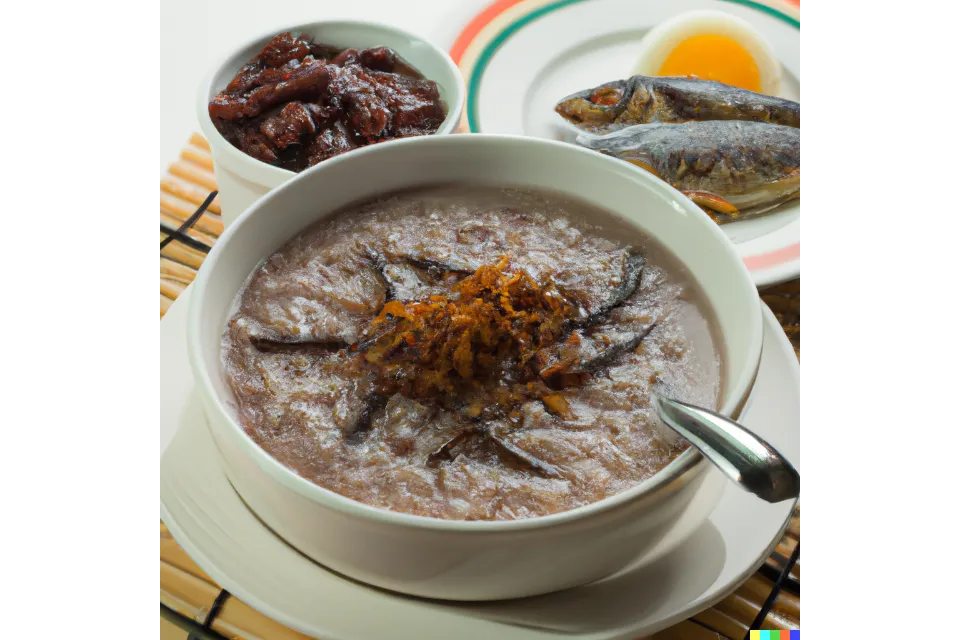
What is Champorado?
Champorado, often spelled Tsampurado, is a chocolatey, sticky rice porridge cooked with Tablea (chocolate disks made of ground-up cacao beans). Filipino Tablea or Tableya, meaning “tablet”, are like ice-hockey pucks of pure chocolate. They are made with local cacao beans that have been fermented, dried, roasted, ground, and shaped into coins or balls. Tablea serves as the main ingredient for Sikwate/Tsokolate (Filipino-style hot chocolate) and Champorado (chocolate rice porridge).
Bohol, home to the Chocolate Hills, has some of the very best Tablea you can find. I highly recommend it. Really deep, bitter, and has high cacao content. It is sublime for cooking with and making those hot chocolates.
What are the origins of Champorado?
While the Filipino Champorado can trace its roots to the Mexican original, Champurrado, it has been modified to incorporate Chinese ingredients and techniques. Instead of maize masa, which is used in the traditional Spanish version, glutinous rice is used in the modern version. This breakfast or noon snack of chocolate porridge sometimes include a side of salted fish or Tuyo to counteract the sweetness.
Halo-halo
Many people joke that the Philippines has two seasons: hot and hotter. There’s no better way to cool off than with some Halo-halo. It’s a crazy assortment of bits and pieces for a dessert but, believe me, they really work together. It’s delicious and super refreshing.
What is Halo Halo?
Halo-halo is a popular Filipino dessert that literally means “mix-mix” in English. It is a cold, sweet, and refreshing treat that is often enjoyed on hot days.
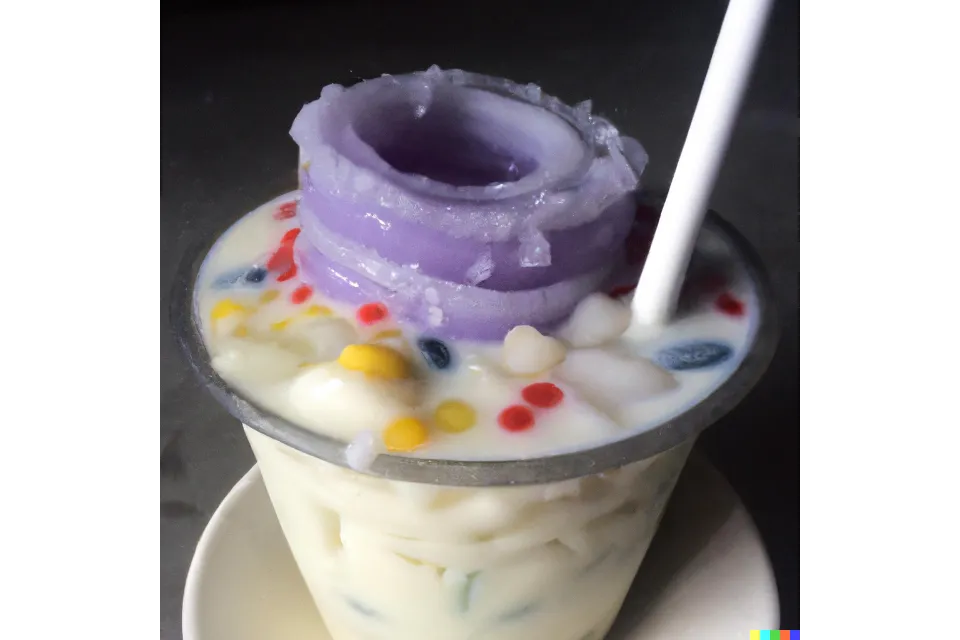
How do you make Halo Halo?
To make Halo-halo, a variety of ingredients are mixed together in a tall glass or bowl. These ingredients typically include shaved ice, evaporated milk, and a variety of sweetened beans, fruits, and other toppings. Some common toppings for halo-halo include boiled sweet potato, ube (purple yam), langka (jackfruit), mango, and red mung beans. Other ingredients that may be added include ice cream, coconut, and leche flan (a type of caramel custard). See what I mean about the crazy ingredients?

Halo-halo is usually served with a spoon, and the idea is to mix all of the ingredients together until they are well combined. The finished product is a colourful and delicious dessert that is enjoyed by people of all ages in the Philippines.
What is the origin of Halo Halo?
The dessert is believed to have originated in the early 20th century, when the Philippines was a deeply involved with the United States of America post WWII. During this time, many Filipinos were exposed to Western-style ice cream and other frozen desserts, and Halo-halo was likely influenced by these treats.
Halo-halo became especially popular after World War II, when the Philippines gained its independence and the dessert became a symbol of the country’s cultural fusion. Today, Halo-halo is enjoyed by people of all ages and is likely available at all Filipino restaurants and many street food stalls.
Soup No.5
Ok, this one is making me wince, and shift uncomfortably in my seat as I type. This is another rather exotic Filipino cuisine, in Soup No.5. Albeit the name sounds truly harmless and just the #5 soup on the soup menu perhaps. But no. It is much, much more than that. This really is an incredible Filipino food.
Because of the dish’s peculiar name, I was curious about what it was, so I did some research on the internet to find out more about it. Apparently, a restaurant tried to appease customers who might experience disgust and nausea by concealing the primary component of this soup by calling it “Soup Number Five” on the menu. That’s quite clever actually because if you look at the picture of Soup No. 5, it looks like many other South East Asian beef dishes.
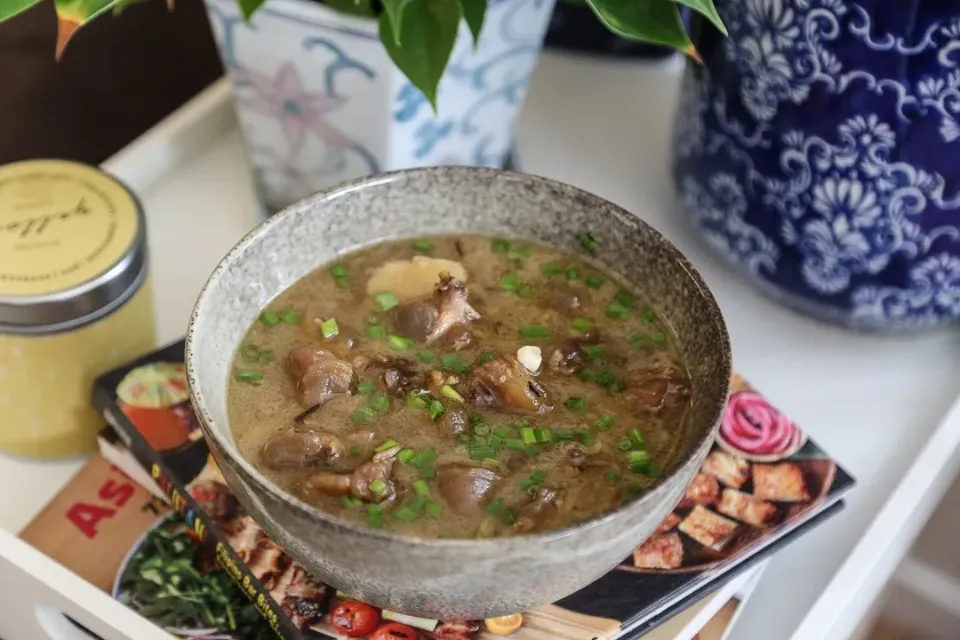
Also, Soup Number Five, with its supposed aphrodisiac and curative abilities, is famous in the Philippines. Some guys think that if they consume it, they’ll gain the sexual strength and stamina of a bull, or at least their desire will go through the roof (unlike the bull’s pen!s will any more).
What is Soup No.5?
Let’s get to it. Soup No. 5 is truly one of the most out-there examples of Filipino cuisine. Filipinos use a bull’s pen!s and testicles in Soup No. 5. See why I was squirming? This soup is usually served with alcoholic beverages (I’d definitely need a stiff one to drink this, ooer). There are also claims that it can alleviate the symptoms of a hangover.
How to make Soup No.5?
Preparing Lanciao, also known as Soup No. 5, requires a fair bit of prep. To get rid of any scum and properly clean the meat ingredients, they should be rinsed and scrubbed a few times, and then parboiled. Rewash the meat and remove any excess skin.
Now that everything is ready, we can begin cooking Soup No. 5. Truth be told, you’re already done with the hardest part, which I would suggest for all male cooks is the slicing up of the pen!s. Squirm.
Caramelize some onion and ginger, and saute the garlic. Browning the garlic is recommended so that it may provide its roasted garlic taste to the soup. Mix in the onions and ginger. Let the onion simmer until it becomes tender. The meat is cut into bite-sized pieces and simmered in a broth seasoned with garlic, onion, ginger, bird’s eye chili, fish sauce, and other spices. Use sugar, ground black pepper, and fish sauce as seasoning.
What are the origins of Soup No.5?
Soup No. 5 is popular in the Filipino Chinese neighbourhoods of Manila, and Cebu. You can find this soup at many of the city’s roadside restaurants. On Cebu, this meal is known as Lansiao, which literally translates as “man genitals” in the Hokkien language. As with many traditional Chinese dishes, it was thought that the earliest Chinese immigrants of Hokkien descent were responsible for its creation in the Philippines.
Soup No. 5 reminds me of trips to Cambodia, and eating Kuy Theaw – Cambodian Beef Curry Noodles in the markets for breakfast. Who knows what was included in that from the cow? Certainly not me. But man was it delicious.
And here is my Kuy Theaw Recipe & Review for you.
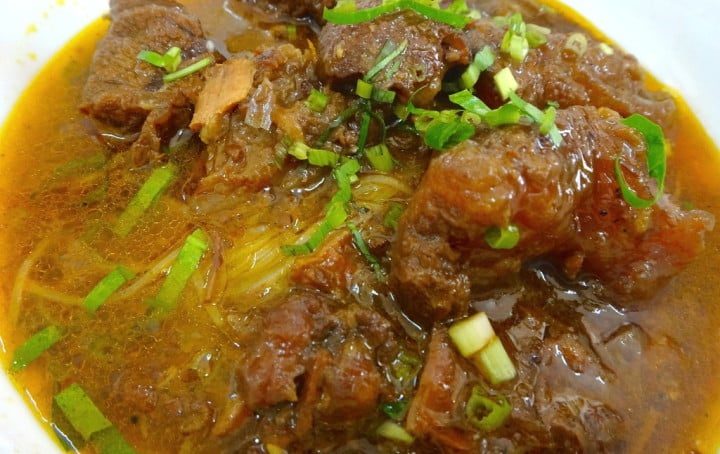
Ensaymada at Tsokolate
What is Ensaymada at Tsokolate?
Ensaymada at Tsokolate is a handmade cheese-bread / pastry. Ensaymada is traditionally made with soft, sweet dough that is shaped into a spiral and then baked until it is golden brown. It is often topped with butter, cheese, and sugar, and sometimes also includes fillings such as ham or ube (purple yam).

Ensaymada is usually served as a snack or dessert and is often enjoyed with a cup of Tsokolate, which is a super-thick and creamy Filipino hot chocolate made with cocoa and Tablea (remember the chocolate puck tablets). Together, Ensaymada and Tsokolate make a delicious and indulgent treat that is popular in the Philippines and among Filipino communities around the world, including my Wife and kids.

How to cook Ensaymada at Tsokolate?
When working with Ensaymada dough, buttering your hands can help prevent sticking. After the dough has been kneaded, it needs to rise for at least an hour in the first stage, and then again for at least 20 minutes before being baked. This extends the time for fermentation, which improves the taste. You have up to 12 hours to let the dough proof. In order to have something baked and ready for breakfast in the morning. Cooks will even start the batter the night before and finish it in the morning.
Sounds very familiar to that other baking labour of love, Sourdough.
What are the origins of Ensaymada at Tsokolate?
Mallorca, one of Spain’s Balearic Islands, is where the Ensaymada tradition began so it seems, in the 17th century. That is one old cake. In the beginning, it was known as Ensaïmada de Mallorca, derived from the Catalan word, ‘saim’, for fat. Pork lard helps to create croissant-like layers in this little pastry. In some modern recipes, butter is used in place of lard to achieve the same result.
The traditional Spanish recipe is regarded so highly that it’s been marked as a ‘protected geographical indication’ to ensure the recipe stays true to its heritage.
The Ensaïmada made its way to the Philippines with Spanish colonization. However, it’s spelled Ensaymada across the archipelago. Similar to the Spanish version, the Filipino Ensaymada is brushed with lard or butter once it’s taken out of the oven. This seeps into the layers of the bread. But while the Spanish one is heavily dusted with icing sugar, the Filipino one is sweetened with a generous amount of butter and caster sugar.
Rellenong Alimasag
The arrival of a crab at the dinner table is always met with great excitement in the Philippines. With this crab meal, Filipinos took a novel approach, because Rellenong Alimasag is a mixture of the cleaned-out crab meat and other goodies, that is placed back in its shell and deep-fried. With all that tasty crabmeat already removed from the shell, this recipe ups the ante considerably – no need for tools and implements, other than a fork to start eating. Genius.
What is Rellenong Alimasag?
Rellenong Alimasag is a Filipino dish with stuffed crabs. It is a popular seafood dish in the Philippines, typically made with whole crabs that have been cleaned out and re-stuffed with a mixture of crab meat, spices, herbs, and other ingredients such as minced pork or shrimp. The stuffed crabs are sometimes cooked in a tomato-based sauce and served with rice, or just served with the rather delicious Filipino banana ketchup.
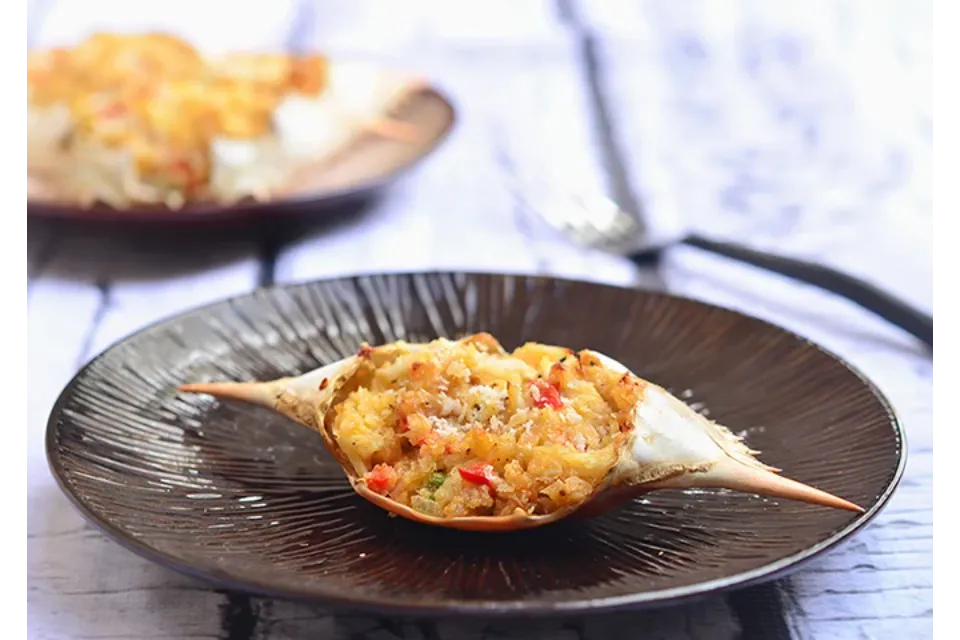
This is sounding uncannily like my Filipino Stuffed Crab Recipe, just minus the tomato sauce.
How to cook Rellenong Alimasag?
The Filipino delicacy known as Rellenong Alimasag is prepared by stuffing crab casings with crab meat and veggies. This delicious crab dish is a breeze to eat, but it’s a major pain to prepare. There are three distinct phases of preparation: first, steam the crab, then remove all of the meat, and then make the combined crab meat filling plus on ingredients. The last step is stuffing that all back in the crab shell, followed by frying.
Yeah, I agree. Easy for the consumer, but on tough one on the cook. But boy does she look good plated up. Worth the effort perhaps…? It’s a wow-factor for your guests.
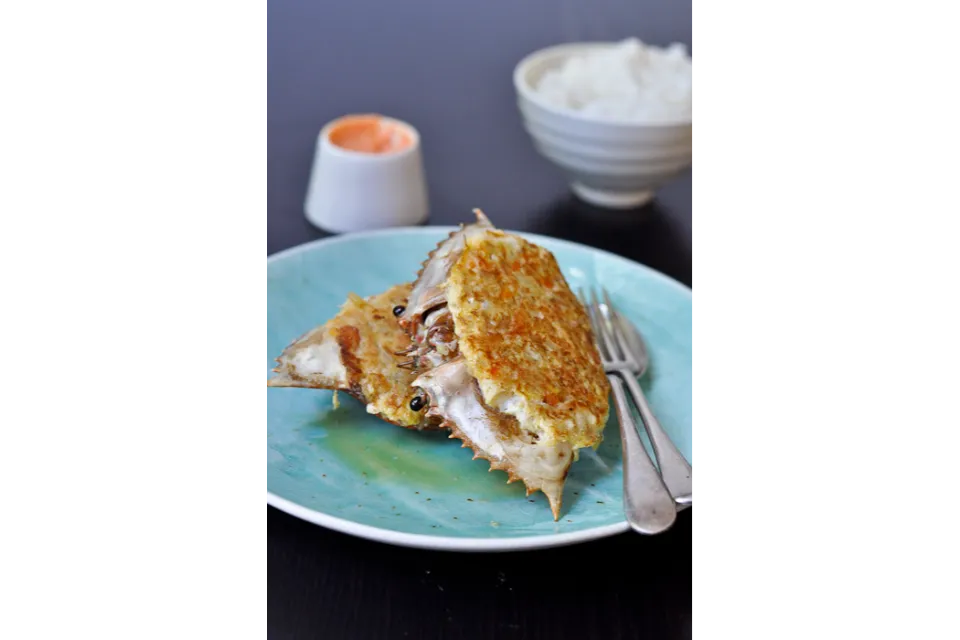
What are the origins of Rellenong Alimasag?
The Spanish influence on Filipino cuisine is, of course, inevitable considering the Philippines were a colony from 1521 to 1898. Ingredients and cooking methods in the Spanish kitchen often make an appearance in Filipino cuisine. And Rellenong is just one other great example.
Rellenong comes from the Spanish word ‘rellenar’ to refill, stuff. The Spanish influence is also not just on crabs for this cooking method, with Rellenong Manok (stuffed chicken), Rellenong Bangus (stuffed milkfish), and so on.
Puto Bumbong
Puto bumbong is a traditional Filipino dessert made of glutinous rice that is steamed and then pounded into a dough-like consistency. It is then molded into small, elongated shapes and cooked in bamboo tubes called “bumbong” over a BBQ. The finished product is a purple-coloured, sweet and sticky rice cake.
It is often enjoyed with butter, grated coconut, and sugar on top. Puto Bumbong is a popular street food in the Philippines, but can also be found in Filipino bakeries and restaurants all over the archipelago.
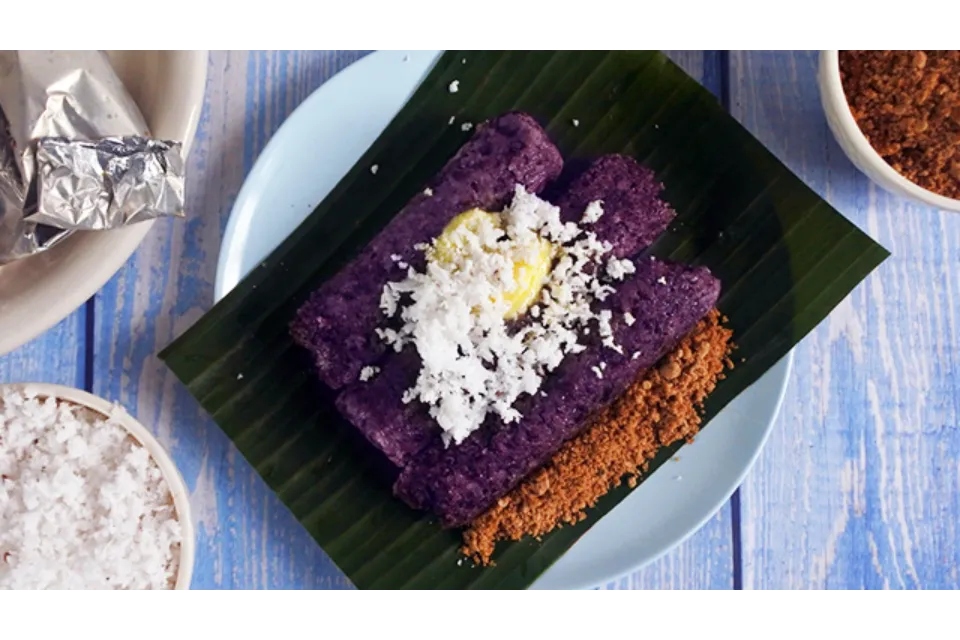
What is Puto Bumbong?
Puto Bumbong are Filipino purple rice cakes, also called Puto Bumbonger or Bumbongizer, are steamed in bamboo tubes. Commonly purchased over the holiday season. Puto is a sort of steamed rice cake.
How to cook Puto Bumbong?
The unique heirloom variety of glutinous rice called Pirurutong is soaked overnight in water (often salted water). The result is a fermented flavour with a touch of acidity. After draining, the mixture is either left as whole grains, on in some recipes it is ground, and then tightly packed into bamboo tubes and steamed. Coconut oil was once the standard for greasing bamboo tubes, but nowadays butter or margarine is more common
After the rice cake has been formed into a cylinder, it is slathered in butter or margarine, sprinkled with muscovado sugar (or just brown sugar/white sugar with or without sesame seeds), and topped with grated coconut. Some variations of Puto Bumbong feature additional ingredients, such as condensed milk.
What are the origins of Puto Bumbong?
Puto Bumbong is a traditional Filipino dessert, and one that has a long history in the Philippines. It is believed to have originated during the pre-colonial period, when rice was the main staple food of the Philippines and was used in many different dishes and desserts.
The name originates from the Tagalog Puto (rice cakes) and Bumbong (or bombon) (“bamboo tube”).
Tamilok
Up next is another Filipino exotic cuisine item. Well, it had to be, didn’t it? We’re aiming to finish strong. And boy this one is a strange one. If you happen to be chopping up any rotten old mangrove trees and have a hunger, this could be the one for you. The infamous Filipino food, Tamilok.
What is Tamilok?
Filipino Tamilok, also known as woodworm or shipworm, is a type of saltwater clam that lives in the wood of mangrove trees. It is a traditional delicacy in the Philippines, where it is often served raw or cooked in vinegar, garlic, and chili peppers. The Tamilok is known for its crunchy texture and slightly sweet taste.
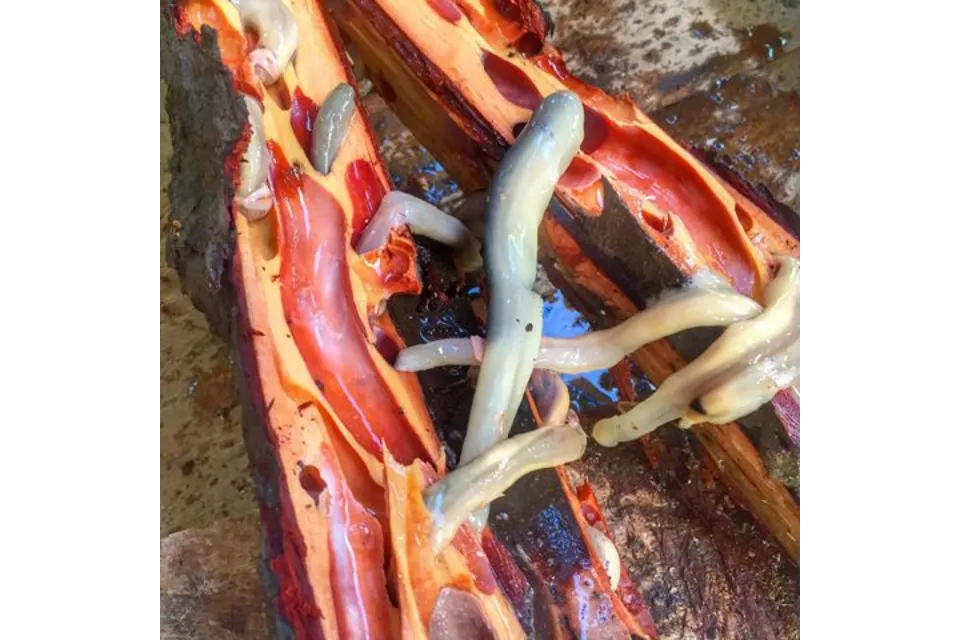
Tamilok resides primarily in mangrove swamps and can be found infesting rotting logs near the shorelines. In order to satisfy your hunger for a juicy woodworm, you will need to slog across slimy riverbeds in quest of drowned trees. Split open a piece of mangrove wood and hope a wriggling clam is hiding inside. Despite the difficulty involved, all the locals attest that the end result is well worth it.
Tamilok is more closely linked to common saltwater clams than they are to a true worm, despite their looks. So actually taste-wise they apparently taste like fresh clams, mussels, and so on, unless not cleaned properly when you will get a hint of decaying wood.
Depending on the species, Tamilok can reach lengths of a few centimetres up to a metre. Thus, yeah, they are frightening-looking and not really very visually attractive for eating, but the locals swear by them. When I say frightening I mean it, here is an old drawing of one in a Natural History journal. Tasty, right?

What are the origins of Tamilok?
The exact origins of eating Tamilok are not well-documented, but it is likely that it has been a part of the local cuisine in the Philippines for many centuries. Tamilok is a highly nutritious and protein-rich food source, and it has likely been a valuable food source for the local indigenous populations for a long, long time.
How to cook Tamilok?
It can be eaten in a variety of ways, but in most ways, it is not really cooked. The most typical method is to cook it in the style of Ceviche by marinating it in vinegar, lemon juice, a pinch of salt, and a pinch of red or black pepper.
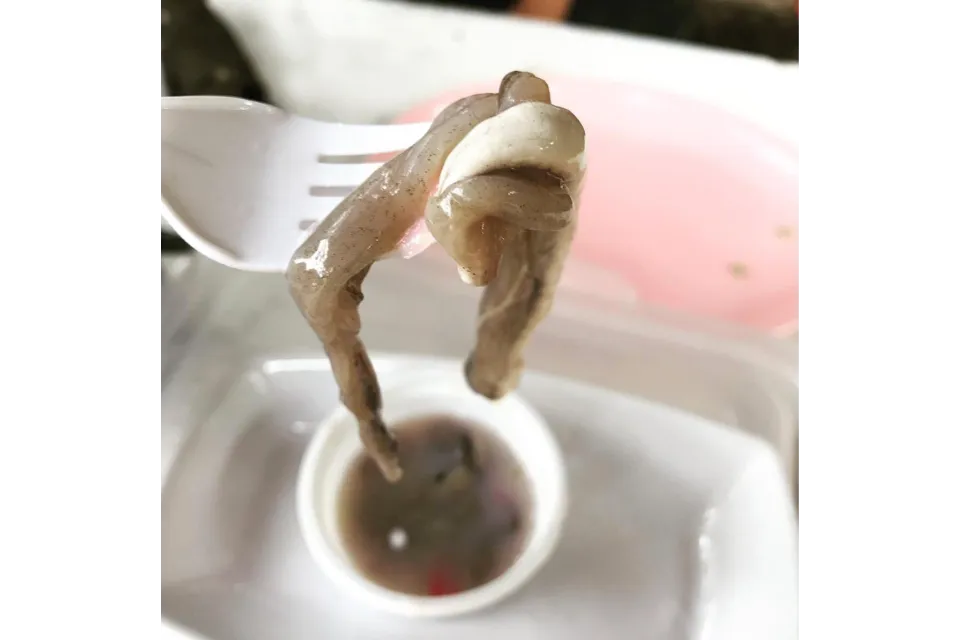
Chicken Heads (Helmet)
The Filipino chicken diet typically includes the consumption of the entire bird, including the head. As a popular form of street food, Chicken Heads aka Helmet are frequently skewered and grilled, or deep-fried. Pulutan is one of my favourite Filipino words, as it means to eat food with booze, and Filipino Chicken Heads are indeed Pulutan. I might need a good few beers prior to me tucking into a hen’s face, brain and beak though.
What are chicken heads in Filipino cuisine?
As mentioned above, chicken heads, be they deep-fried or grilled, are Pulutan food in Filipino cuisine. It snacks on skewers accompanied by alcohol. I couldn’t agree more with the food philosophy of Pulutan.
How to cook chicken heads in Filipino cuisine?
Colloquially known as just “helmet”, Filipinos love to eat fried or grilled chicken heads on skewers. The skin covering the chicken head has more fat deposits than the chicken feet. And fat is flavour. If you’re brave enough you can pop open the skull and suck out the brain and other entrails.
Deep-fried Helmet
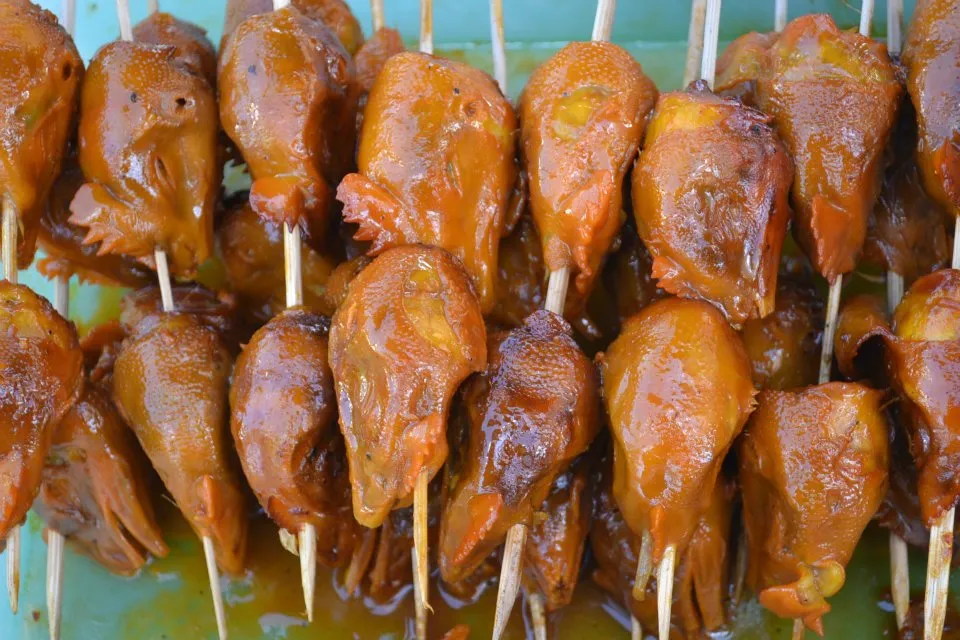
BBQ grilled Helmet

What are the origins of eating chicken heads in Filipino cuisine?
It’s really simple because in the Philippines no part of any animal goes to waste. And that is a philosophy we should all adhere to. The animal gave up its life to feed us, and we should respect every part that is edible. Bravo Filipino cuisine.
Chicharon Bulaklak
Our final three entries of 40 unbelievable Filipino foods were strong finishers. And this, our final Filipino food is no exception.
If you don’t like fried food, don’t come to the Philippines would be one of my personal recommendations. I am seriously joking when I say this, by the way. But, Filipinos do like to fry just about everything (it’s like being in a warm Scotland with a nicer accent), and for a good reason. Who can resist something deep-fried and crispy? Certainly not me. Take a local delicacy called Chicharon Bulaklak for example. It is deep-fried pig intestinal bits, which are also known as pork intestine railings. Sounds delicious, right?
Bring it on baby, nose-to-tail, and guts continue on strong in Filipino cuisine.
What is Chicharon Bulaklak?
The intestinal bits, AKA pork intestine railings, curl into flower shapes when fried, and, because of that, they were given the Tagalog name for flowers, Bulaklak. Beer drinking (Pulutan) sessions typically feature them with a spicy vinegar dipping sauce, but you may also have them as a light afternoon snack (pssst my personal recommendation is to absolutely have it with the spicy vinegar and icy-cold beer). Chicharon Bulaklak is at its very best straight after frying when still warm and the texture is extra crispy, and that beer is just out of the ice.
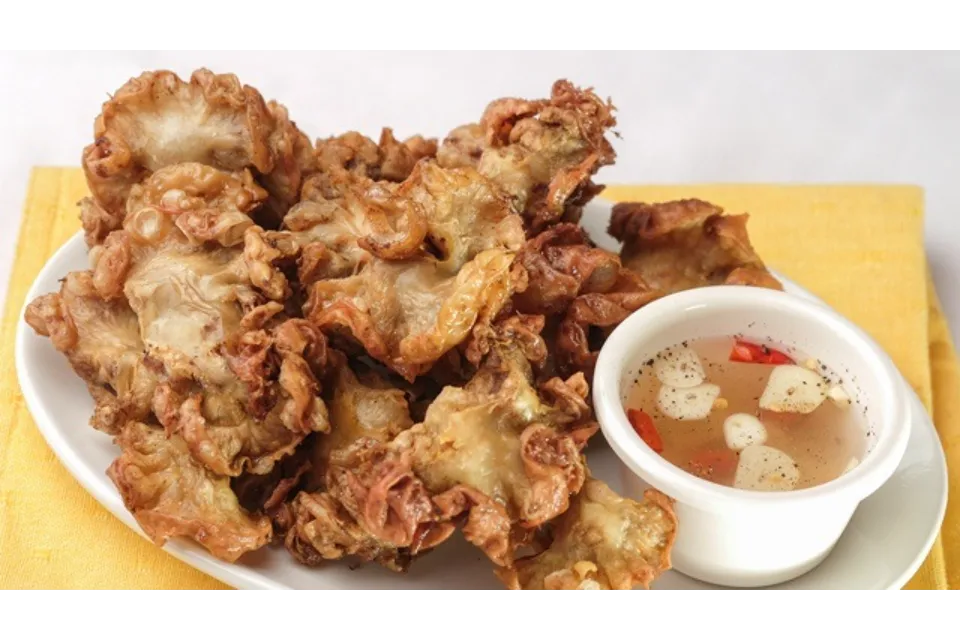
How to cook Chicharon Bulaklak?
Critical steps in cooking this crunchy snack is in the preparation, and the proper cleaning and cooking of the pork. One way to make cooking this pork dish easier is by chopping up the Bulaklak for faster cooking. Another is by completely drying the pork after the boiling phase, and just before frying it so it can become as crispy as it can be.
I am using some of my cooking experience here, but I’d also give it a brine in some salted boiling water for 20-30 minutes. This would clean the intestinal bits nicely, likely make them more tender, and add seasoning. Then dry, then deep-fry in super-hot oil for immediate crisping, and to lessen the chance of them being oily.
What are the origins of Chicharon Bulaklak?
The origins of Chicharon Bulaklak are not clear in the history of Filipino food, but it is likely that the dish has been enjoyed in the Philippines for many 100’s of years. Pork is a hugely popular ingredient in many Filipino dishes, and the use of offal and organs (the nose-to-tail approach), in Filipino cooking is also common. The technique of deep-frying to preserve and enhance the flavour of meats is also commonplace in the Philippines.
Chicharon Bulaklak
Chicharon Bulaklak is such a famous Filipino food that is formed from hog intestines that have been deep-fried to a crisp. It is also known as crispy fried pork ruffles. This salty and crunchy food has been a mainstay in the Philippines for many years, and it is popular not only among residents but also among visitors to the country. My kids absolutely love it. Every time we go to Payag in Tagbilaran it is the first thing they’ll order.
After the swine intestines have been cleaned and boiled, the next step in the process is to break them up into little pieces and marinate them in a mixture of vinegar and various spices. The finished product is called chicharon bulaklak. After being marinated, the intestines are then fried in oil at a high temperature until they become crisp and golden brown. The end product is a delectable snack that is crunchy on the exterior and tender and soft on the inside.
Its singular flavor and mouthfeel are two of the many attributes that contribute to chicharon bulaklak’s widespread appeal. It is a fulfilling and delectable snack because to the combination of savory flavors from the marinade, as well as the crunchiness of the exterior and the tenderness of the interior. It is also a simple and convenient food to eat, as it is frequently sold pre-packaged in snack portions, which makes it an ideal snack to take with you when you are on the go.
Chicharon bulaklak is also frequently consumed as a snack during social gatherings or as a side dish to go along with meals. It is also possible to serve it as a main meal, generally accompanied by rice and some kind of dipping sauce (vinegar or soy sauce, for example).
In conclusion, chicharon bulaklak is an appetizer that anybody who visits the Philippines absolutely needs to try. A tasty and gratifying snack that is sure to satiate any cravings for something crunchy and savory, thanks to its one-of-a-kind flavor, pleasant texture, and convenient nature. It does not matter if chicharon bulaklak is consumed as a snack or as a component of a meal; either way, this classic dish of the Philippine culinary tradition is certain to leave an indelible mark.
Chicharon Bulaklak is like the Philippines street food version of KFC, but 1,000 times better. It is a die-die must-try.
Pulutan, is something you must know about when eating Filipino food
I had to include a small write-up on Pulutan, as it certainly was a common theme throughout most of the 40 unbelievable Filipino foods reviews. Boozing on beer, native rum, and even Tuba is commonplace over food in the Philippines. I should know, as I love Pulutan. In the West, we’d know it as beer food, bar snacks, and so on.
What is Pulutan?
Pulutan is literally a term used in the Philippines to refer to small dishes or snacks that are served with alcoholic drinks, typically during social gatherings or parties. These dishes are usually savoury and are meant to be enjoyed as a complement to the drinks.
Some common examples of Pulutan include many of the writer’s favourites:
- Sisig – my beloved dish made from pork, usually the ears, cheeks, and jowls, that is seasoned with vinegar, chili peppers, and other spices and then served on a sizzling platter;
- Tokwa’t baboy – a dish made from fried tofu and boiled pork belly, often served with a dipping sauce made from soy sauce and vinegar;
- Chicken wings (of course) – deep-fried chicken wings, often coated in a spicy sauce;
- Kinilaw – a favourite of my wives is that dish made from raw fish or seafood, typically marinated in vinegar and seasoned with spices and other ingredients such as onions and chili peppers;
- Lumpia – a type of spring roll filled with a variety of ingredients, such as vegetables and meat, and then deep-fried;
- And so on…
These are just a few examples of Pulutan. Believe me, there are many more dishes that are commonly served as Pulutan in the Philippines. Like all of our 40 unbelievable Filipino foods. Filipinos love Pulutan.
Conclusions of 40 unbelievable Filipino foods
I have personally eaten a lot of these dishes in my 13 years of visiting and exploring the Philippines, eating Filipino food. Most of those were Pulutan oriented. When I first visited I was hearing from non-Filipino people that Filipino food was bland and uninteresting. How far from the truth could that be? From the savoury Adobo to the sweet Halo-halo, Filipino food is a celebration of the country’s history and culture, and it continues to be enjoyed by people all over the world.
The history of Filipino food is a rich and diverse tapestry, influenced by a variety of cultures and historical events. From the indigenous dishes of the pre-colonial period to the influences of Spanish, Chinese, and American colonization, Filipino food has evolved into a unique and flavourful cuisine that reflects the diverse history of the Philippines.
I love the eat everything, nose-to-tail practice. That surely does get your juices, and sometimes blood pressure racing. Eat with your mouth, not your eyes is something to be practiced here with some of the dishes laid in front of you. But, the next time you sit down to enjoy a plate of Sinigang, Sisig, Crispy Pata, or Pancit, take a moment to appreciate the rich history and cultural influences that have shaped this delicious and unique cuisine.
But, Tamilok is one Filipino food dish I think I might have to pass on.
However, I’d love another bull’s pen!s and balls soup please, plus an icy-cold beer to wash that big boy down!!!
So how did you enjoy the journey, the Filipino food journey across Pangasinan, Baguio, Batangas, Quezon City, Sinulog Festival, Pampanga, Palawan, San Juan, Davao City, Panagbenga Festival, and Baguio City?

